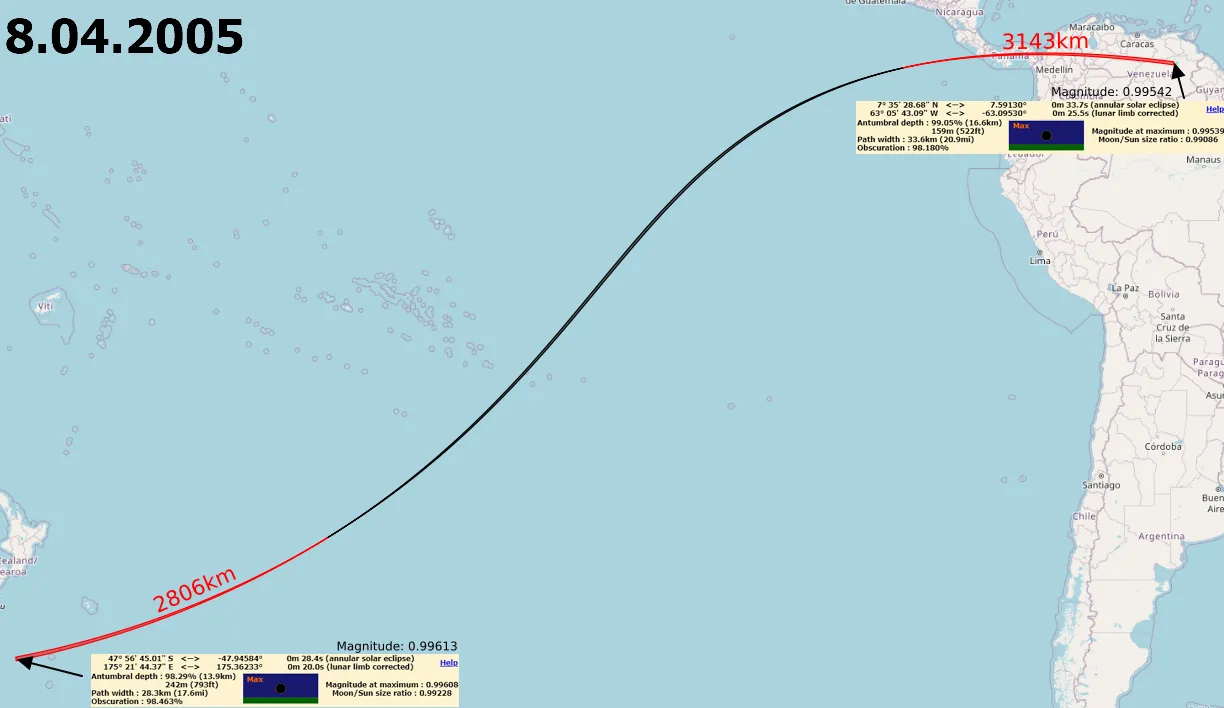What exactly is a hybrid solar eclipse?
This text is aimed at explaining to you what roughly is the hybrid solar eclipse phenomenon. In my opinion, most sources define the hybrid solar eclipse incorrectly, defining it as the eclipse, in which one type morphs into another or sometimes, just a total solar eclipse, which most people want to see under these oddball eclipse circumstances. For example in the current sources about the forthcoming hybrid solar eclipse on April 2023, we can read, that in Exmouth (WA) the “hybrid solar eclipse is expected to occur“, whereas, in reality, it will be the total solar eclipse with duration about 1 minute. In fact, the same text says later about “the totality of the eclipse“. Another source explains this type of eclipse much better, writing that it’s “a hybrid between an annular eclipse and a total eclipse“.
1. THE GENERAL DEFINITION OF A HYBRID SOLAR ECLIPSE
In other cases, the hybrid solar eclipse is defined as the “combination of three eclipse types” that are derived from the parts of the Moon’s shadow and cannot be experienced in all its glory. The eclipse across its path shifts between annular and total with obviously partial phase outside of the main path. In practice when the Earth enters the Moon’s shadow, an observer can see the total solar eclipse. Conversely, when the Moon is too far from the Earth, is unable to cast the full shadow on its surface. Then an observer can be placed at most in antumbra and watch the annular solar eclipse. Finally, for an observer positioned in the penumbra, the partial phase will occur. In conclusion, the hybrid solar eclipse tends to be perceived as the combination of these three types of eclipses accordingly the partial phase (so-called the Devil’s horns), the annular one (called also the “Ring of fire”), and finally the total (“Complete darkness”). Moreover, with respect to the last one, we already know, that “complete darkness” never happens.
In another way, the hybrid solar eclipse is clarified as the eclipse, which both begins as an annular phase when the path first touches the Earth and ends as an annular phase when the Moon’s shadow leaves the Earth, but which becomes a total for a period in-between. A hybrid solar eclipse usually means that some locations experience just an annular solar eclipse, whereas other locations can excite the totality. It’s all down to the Earth’s curvature. Sometimes, when referring to a particular moment, in which a hybrid solar eclipse takes place, the phenomenon is called the “beaded” solar eclipse or even a “fractured annular eclipse”. The second one in my point of view is quite inappropriate and explained in detail below. More accurate is another way of calling hybrid solar eclipses annular-total solar eclipses, which exactly reflects the circumstances of the whole path.
In my point of view, the hybrid solar eclipse should be just the transition moment between the annular and total phases and vice versa. This particular stage is the central and umbral type of the solar eclipse at once unlike annular or total ones, which are indeed umbral, but not necessarily central from some example location.
2. THE TRUE GEOMETRY OF A HYBRID SOLAR ECLIPSE
The Moon’s umbral shadow is cone-shaped and tapers to the mathematical point called the vertex. Beyond the vertex, the shadow diverges as it stretches to infinity (Espenak, 1984). If an observer is between the Moon and its shadow vertex, then the total solar eclipse is observed. In other cases, we can see just the annular phase. The place, where the vertex meets the observer’s eye gives the opportunity for watching the hybrid solar eclipse.
For the sake of simplification, the hybrid solar eclipse is just a moment during the umbral journey across the Earth’s surface. This moment can be explained as the “junction” between the antumbra and the umbra or vice versa and again, occurs as a result of Earth’s curvature. The most extreme places, where solar eclipse starts and finishes are further from the Sun than the place, where the eclipse occurs near midday (Pic. 1-2).
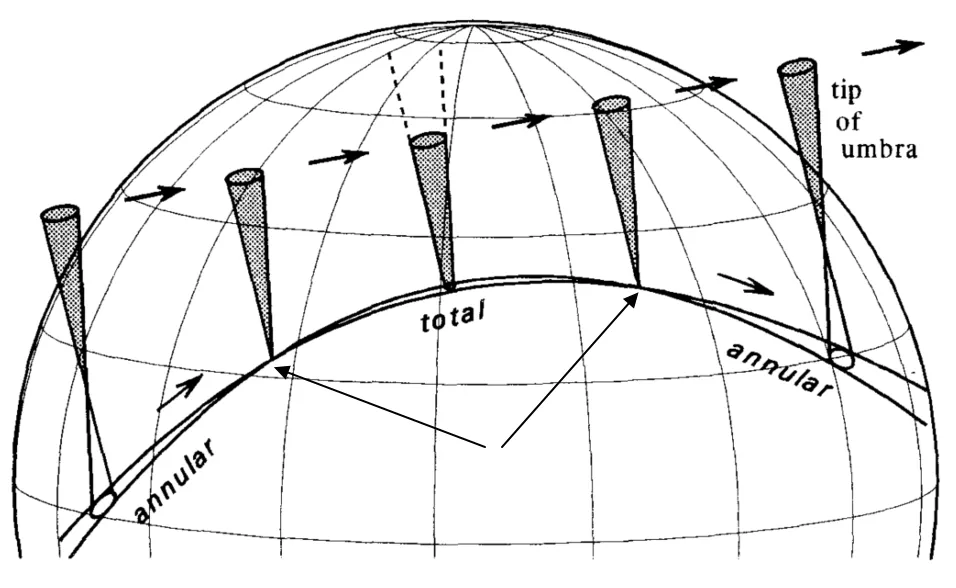
Pic. 1 Following J.Meeus we can see the example of the annular-total solar eclipse, which starts as annular, then becomes total, and finally returns to annular, because the roundness of the Earth reaches up and intercepts the lunar shadow near the middle of the path. Black arrows show the transitional points, which would correspond to the true hybrid solar eclipse event in my point of view (Meeus, 2002). Modified.
Above, we can see the standard graphic representation of the hybrid solar eclipse geometry. This type of eclipse occurs only in the situation when the umbral cone touches the Earth’s surface. Usually, it doesn’t happen near sunrise and sunset where due to the Earth’s curvature the umbra is too short to reach the observer. In turn, he can watch just the short “ring of fire” instead. For around midday watchers, the same eclipse turns into totality. Next, as the eclipse path proceeds toward the end, the eclipse turns annular again.
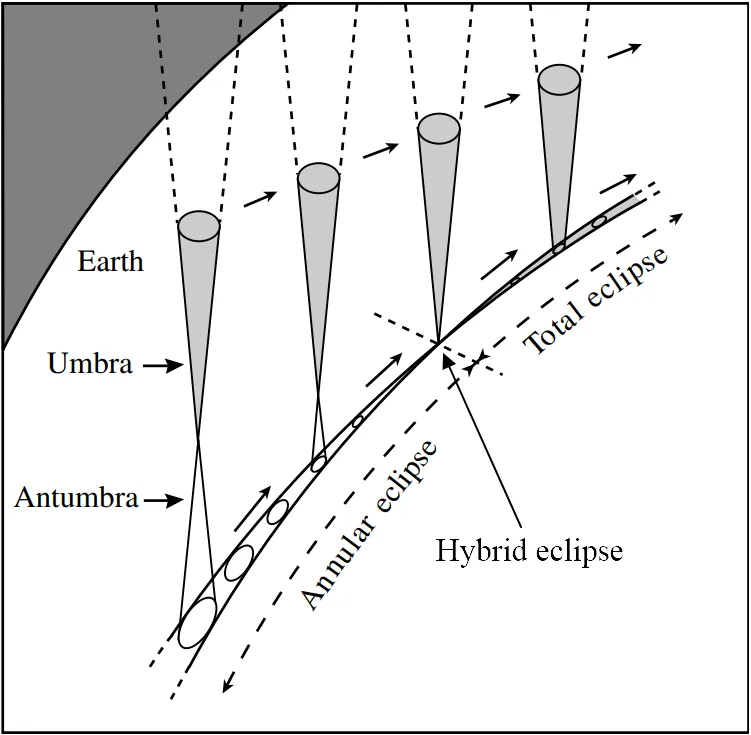
Pic. 2 The pattern for a true hybrid solar eclipse event based on my own opinion, which falls roughly at the transitional point from annular to total phase, where magnitude (in the mathematical sense) is exactly 1 (Litmann, Espenak, Wilcoxx, 2008). Modified.
The graph above clearly depicts the essence of the hybrid solar eclipse. At the moment of the annular phase, the umbral conical tip passes above the Earth’s surface never touching it. Conversely, at the moment of the total phase, the point of the umbral cone passes underneath the Earth’s surface, as this particular part of the planet is a bit closer to the Moon, facing it directly at midday.
The hybrid solar eclipse should refer just to the transitional point between an annular and total solar eclipse, which is the most interesting. This is borderline between annular/total conditions. In other words, we could say, that a hybrid solar eclipse occurs roughly where the umbra “meets” antumbra. This transitional point roughly coincides with the lunar limit for casting a full shadow on the Earth. We shall consider this transitional point also with respect to local altitude above sea level as well as the ground itself, taking into account possible eclipse flights (Pic. 3-4).

Pic. 3 The close-up view at the transitional point of a hybrid solar eclipse (marked red) was observed in April 1912 (Moreoux, 1912).
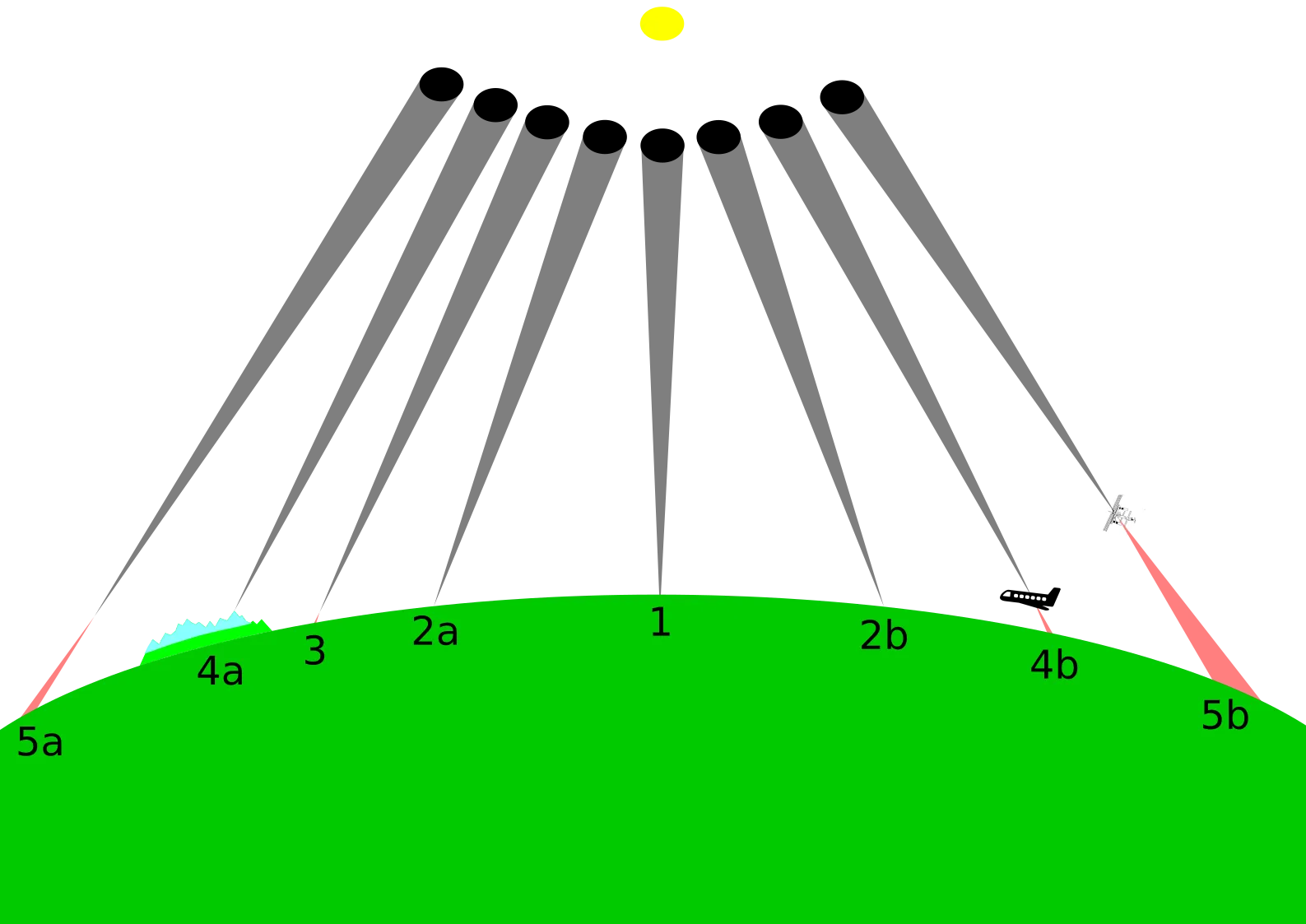
Pic. 4 The detailed visualization of the hybrid solar eclipse occurrence for various observation circumstances, where: 1 – the total phase occurring near midday, as the geometrical umbral apex goes beneath the ground; 2a,2b – the rough places on the ground, where the hybrid solar eclipse occurs, as the umbral apex just “touches” the Earth’s surface; 3 – pearled annular solar eclipse occurrence for ground-based observers; 4a,4b – the hybrid solar eclipse occurrence for significantly elevated positions (i.e. highest mountain ranges or cruising altitudes) whereas the pearled annular solar eclipse is to be observed on the ground; 5a,5b – just pearled annular solar eclipse can be observed except the Earth orbit. Click to enlarge.
In the future, I am going to take a deep look into the geometry of the circumstances described in the image above from a mathematical point of view.
3. THE VISIBILITY OF A HYBRID SOLAR ECLIPSE
The moment of a hybrid solar eclipse marks the situation, in which the apparent sizes of the Moon and the Sun are exactly the same. They’re expressed in a magnitude value equal to exactly 1. In fact, the same value of magnitude also corresponds to the northern or southern edge of the totality path, to which an analog moment could be assigned. In a mathematical sense, this moment is endlessly short. From the visual perspective, the total disappearance of the Sun never happens in these 2 situations, which is driven by lunar topography. For observers standing roughly at the edge of the totality path, where both 2nd and 3rd contact is never observed, they can enjoy extended Bailey’s beads instead. This particular region is called the grazing zone as the “transition” between the partial and total phases of the eclipse. As the watcher moves slightly inside the path, Baily’s Beads are less frequent until disappear completely giving space for a very brief total solar eclipse. When a hybrid solar eclipse takes place, things happen analogically. The solar rays still shine through lunar valleys and create effectively the series of Baily’s Beads visible around the complete circumference of the Moon. The density of these Baily beads decreases as we move from annularity toward totality. In the opposite direction, the density of Baily’s Beads increases merges, and becomes wider. Then we can talk about the pearled annular eclipse. Continuing the movement toward annularity, an observer could eventually experience the broken-ring eclipse, typical for very deep annular eclipses, in which the solar ring is broken by the highest lunar mountain ranges. Everything is presented well in the image below (Pic. 5).
Pic. 5-6 The visual sequence of annular-total solar eclipse
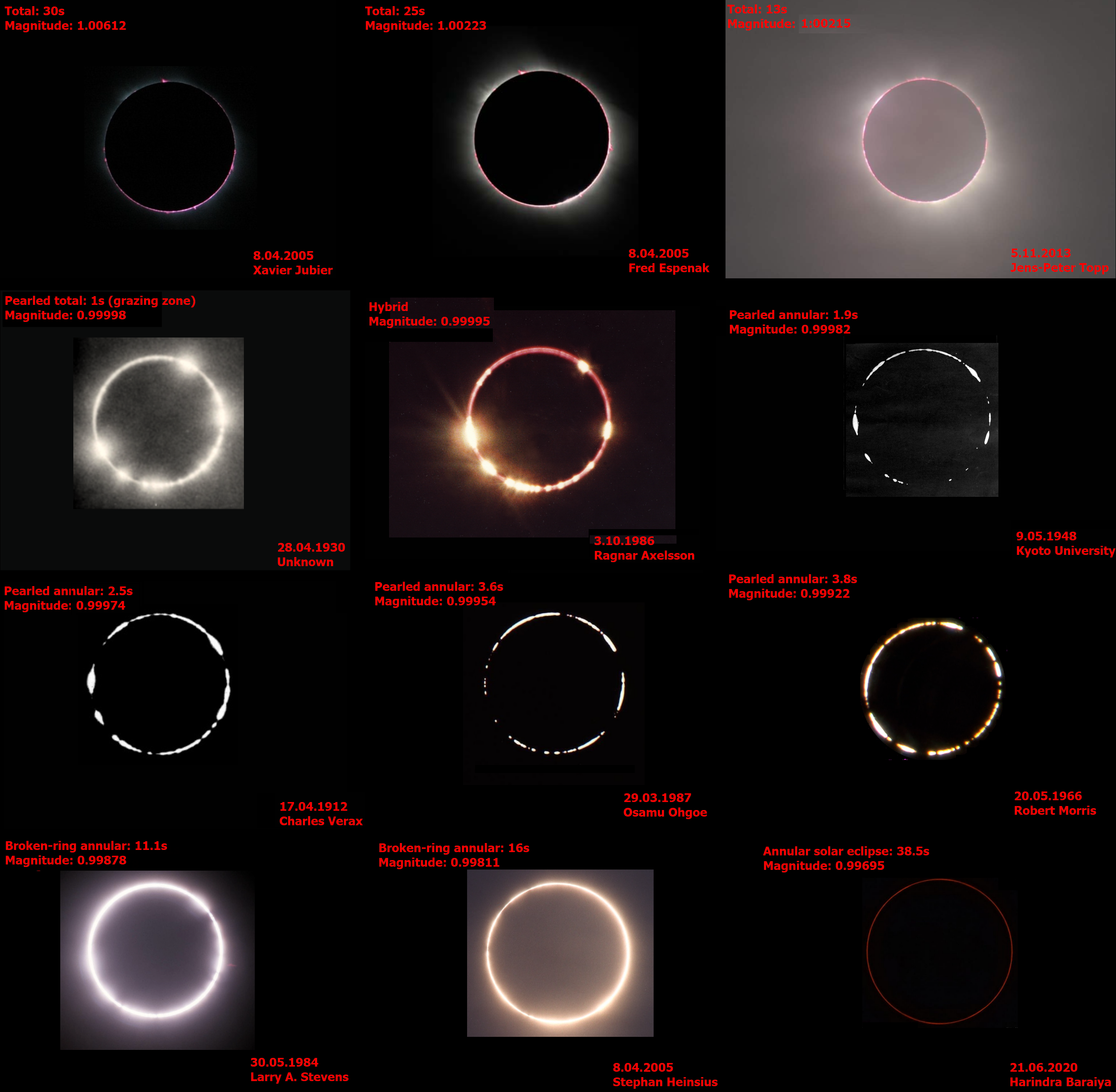
Pic. 5 The visual sequence of a hybrid solar eclipse (from total to annular) as composed from various observations between 1912 and 2013 (Various authors mentioned in the image). Click to enlarge.
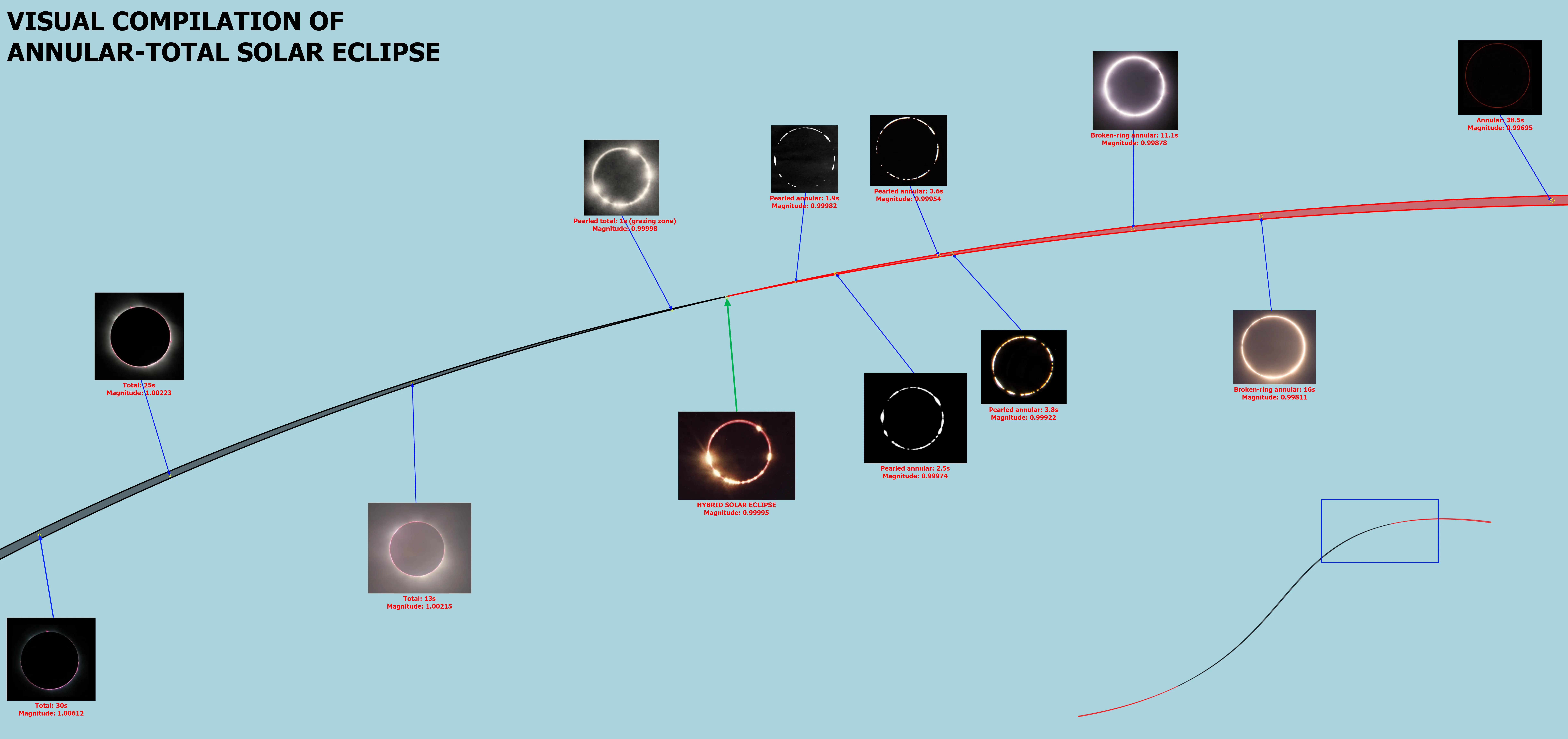
Pic. 6 Visual compilation of annular-total eclipse based on the images captured across modern history between 1912 and 2013 (Authors the same as listed in the image above). Click to enlarge.
The exact hybrid case represents the situation, in which Baily’s Beads literally sparkle over a considerable arc of lunar limb (Mobberley, 2007), which was best recorded on October 3, 1986, when the most extreme hybrid solar eclipse in modern times occurred. These circumstances remain roughly the situation when the eclipse “becomes something neither annular nor total”.
If the observer is close to the point on the track, where annularity turns into totality, it may feel, that Sun never disappears completely. The chromospheric glow on the second contact side will barely have disappeared before it reappears on the third contact side swiftly followed by the emergent Baily’s Beads and the third contact diamond ring (Mobberley, 2007). In other words, the hybrid points mean incomplete photospheric extinction due to lunar topography as well as its flattening (6 km difference between equatorial and polar radius). The hybrid point can be considered as long as any photospheric light steeps through any valley at the deepest part of the eclipse because the totality hasn’t been achieved from the viewing site (Mobberley, 2007/ Meeus, Grosjean, Vanderlen, 1966). This is also the reason why Fred Espenak’s NASA predictions take into account a slightly smaller lunar radius (equal to 0.272281 of the Earth’s one) than proposed by the International Astronomical Union (IAU)(k = 0.2725076). Espenak’s one excludes mountain peaks and valleys along the Moon’s limb (Espenak, Meeus, 2006) unlike the radius defined by IAU, which leads to the misidentification of some hybrid and annular eclipses as total (Espenak, Meeus, 2006).
The primary difference between these 2 values is the type of eclipses, to which they can be applied. The larger value is used for all penumbral and annular solar eclipses, as it represents a mean over lunar topographic features. Conversely, the small one, because represents the mean minimum radius was reserved exclusively for calculations of total eclipses (Explanatory Supplement, 1974).
On the other hand during very short totalities the lunar disk is surrounded by extensive solar corona and the prominences on either side (Pic. 7).
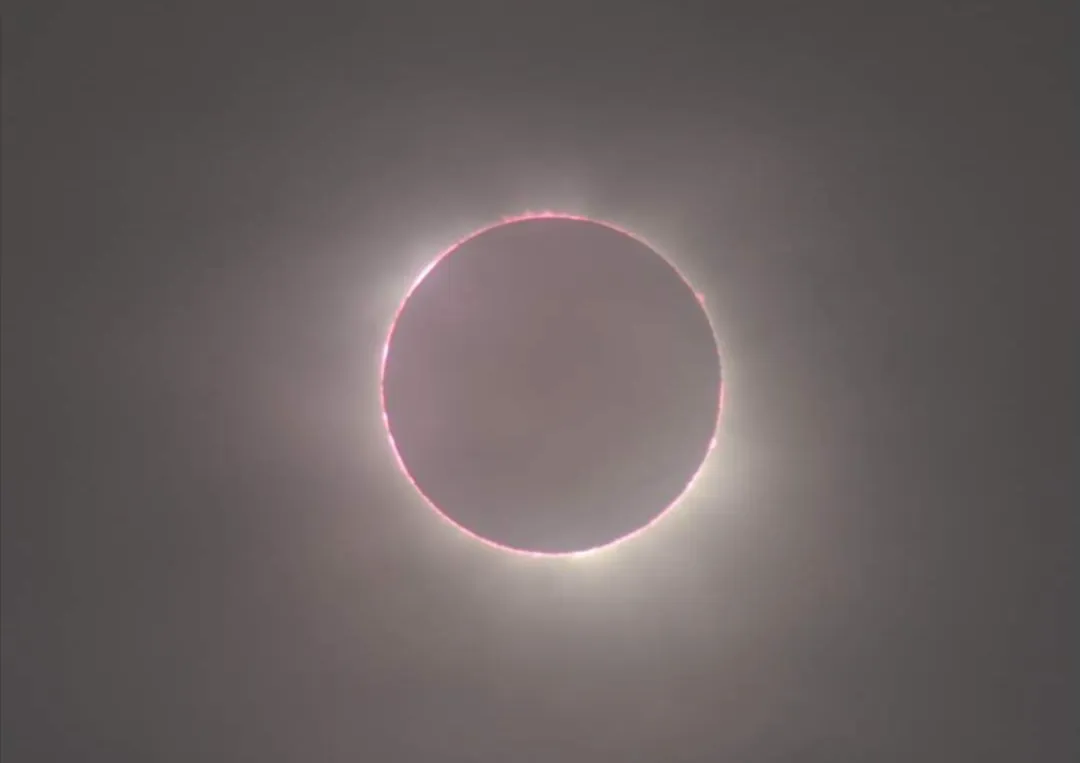
Pic. 7 The best example of a “shallow” total solar eclipse was observed on November 5, 2013, in Uganda, where the totality lasted just 13s. Because the apparent size of the lunar disk was just a tad larger than the solar one, the crimson prominences or even the whole chromosphere can surround the lunar disk completely for the entire event (Jens-Peter Topp/FB-Solar Eclipse Chasers).
Moreover, a brief total eclipse such as this gives a nice opportunity to observe the double diamond ring (discussed later) and the innermost parts of the white-light solar corona visible around the lunar limb (Pasachoff, et al., 2006).
4. RARITY OF HYBRID SOLAR ECLIPSES
Nowadays, various sources inform, us that one hybrid solar eclipse is observed more or less in a decade. In fact, when referring just to the current period between the 2000s and 2040s we can admittedly notice just one hybrid solar eclipse event per decade. It’s pretty true, but the situation is more complicated than we could think. This is because hybrid solar eclipses are not uniformly distributed in time.
In the span of 8000 years considered by Fred Espenak’s and Yuk Tung Liu’s calculations, hybrid solar eclipses account for just 4.8% of all solar eclipses. Their frequency is modulated by a sinusoidal cycle lasting approximately 17 centuries (Espenak, Meeus, 2006). Therefore the number of hybrid solar eclipses can vary between just 0 to even 25 per century, but in rare cases, this number can reach even 28 (Pic. 8).

Pic. 8 Number of hybrid solar eclipses against other types of solar eclipses between BC 4000 and AD 4000. Image captured from Eclipsewise.com website and further modified by data from Yuk Tung Liu’s computations covering the eight-millennium period. The main author explains also the following: a – The first value is the number of central annular eclipses, while the second (in square brackets) is the number of non-central annular eclipses; b – The first value is the number of central total eclipses, while the second (in square brackets) is the number of non-central total eclipses (Fred Espenak/Eclipsewise.com|Yuk Tung Liu/Ytliu.epizy.com)
In the XXI century, for instance, this type of eclipse accounts for only 3,1% (7 out of 224) of all solar eclipses in the previous century we could observe only 6 out of 228 (2,6%) (Pic. 9).
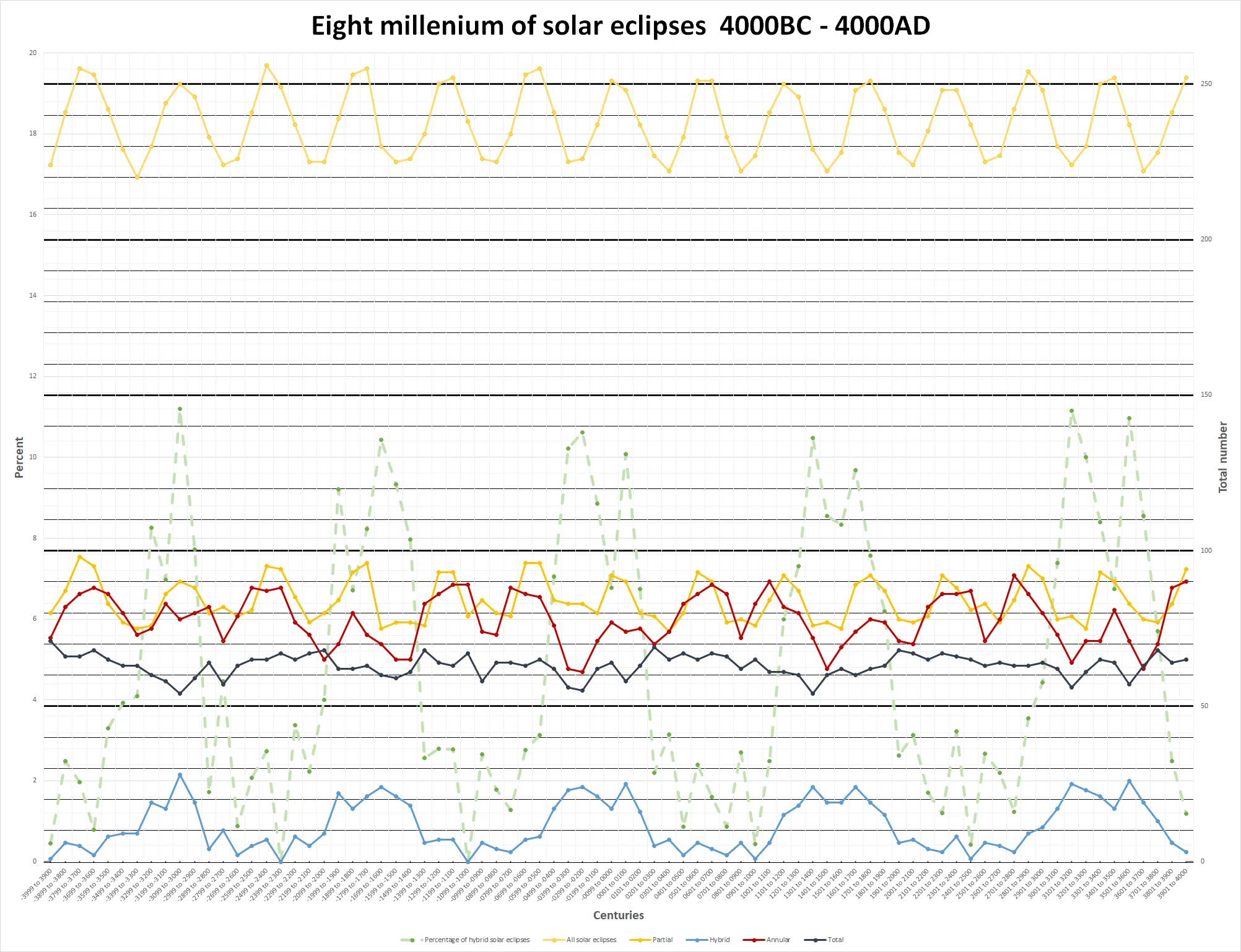
Pic. 9. The number and frequency of hybrid solar eclipses against other types of eclipses in the span of 8000 years (BC 4000 – BC 8000), based on F. Espenak and Y. Tung Liu calculations. Click to enlarge.
Is it correct to define the frequency of the hybrid solar eclipse event as “once a decade” then? Indeed, by looking at the graph above (Pic. 7) we can read that each century contains about 5 hybrid solar eclipses on average. Dividing them by 10 as per the length of a decade, we will have 0,5 which can be rounded to 1. For the long-term period, concluding the hybrid solar eclipse as an event happening just “once a decade” seems to be still correct. On the other hand, in centuries rich in hybrid solar eclipses, events such as these can occur up to 6 times per decade! Moreover, some or even all of them might occur in pairs, which you will read about later in this text. Another approach for the periods featuring scarcity of hybrid solar eclipses can be found in this explanation, which says, that this type of eclipse occurs once in about 160 years. This is also not true, because if it were so, the table above would include the numbers just between 0 and 1 instead of between 0 and 25. Indeed, across the eighth millennium period considered, there are only 2 centuries without any hybrid solar eclipse, which certainly falls within the period without hybrid solar eclipses listed in the table below (Tab. 1).
Tab 1. The examples of the longest periods without hybrid solar eclipse in the span of 8000 years between BC 4000 and AD 4000. We can see a few periods with duration over 100 years, which are strictly repeatable.
The longest periods without a hybrid solar eclipse are repeatable in length but occur irregularly within the considered period. For example, the period of 113 years 10 months, and 2 days occurred between BC 22.02.3853 and BC 24.12.3740, next accordingly BC 23.09.2562 – BC 25.07.2448 and another one will be only between AD 29.04.2386 and AD 1.03.2500. The period of 113 years 10 months, and 3 days was observed between BC 4.02.3694 and BC 7.12.3581, next, accordingly BC 5.09.2403 – BC 8.07.2289, and the last one between BC 6.09.775 and BC 9.07.661. The longest period observed is 131 years 10 months and 12 days, but NOT 160 years! On top of that, a situation such as this is observed just once in the analyzed period. We could assume, that the most often period without the hybrid solar eclipse occurrence is about 113 years, which occurs in a series of 3 periods in the span of 450 years, after which disappears for the span between 1000 and 1200 years. Obviously, this is just an average, for making things simple.
In the case of a hybrid solar eclipse occurrence, the primary factor is that both the Moon’s and the Sun’s distance to the Earth has to be just right. It does explain away the other reason, that stresses the rarity of these events is the enormous restriction of the path, within which the phenomenon can be observed. While any kind of annular or total solar eclipse represents the distance in which the event can be seen, the moment of a hybrid solar eclipse is in fact infinitely small. Analyzing the .kmz files produced by Xavier Jubier’s eclipse interactive maps we can assume, that the minimum distance, within which the true hybrid solar eclipse can be observed is something between 100-150m (Pic. 10). Indeed, this is pretty much minimum distance, which can be considered for visual changes of the lunar parallax. The same we can face standing at the edge of totality, which won’t be marked clearly but expressed rather like the “transition” between penumbra and umbra.

Pic. 10 The local circumstances of the 2023 Hybrid solar eclipse near the Kerguelen Islands, where the estimated width of the eclipse path is as short as 100-150m (Xjubier.free.fr/Google Earth/QGIS).
Usually, hybrid solar eclipses are central with two limits, but in extremely rare cases they might occur just in one limit. In practice, it means, that the hybrid point could fall roughly at the edge of the Earth’s surface near the polar regions. A situation such as this has been calculated as a probability of one out of every 600 million eclipses or once for every 250 million years (Meeus, 2002). Another extremal occurrence within the hybrid solar eclipse event is its duration. Obviously across the path, where a hybrid solar eclipse can be observed the longest total phase might reach up to 1m45s (17.12.437BC, 11.09.508, 28.01.1199, 8.07.1423) or even 1m48s (13.08.979BC), not yielding that much, for example, the forthcoming 2026 totality (2m18s) or even exceeding the maximum duration of some total solar eclipses like 14.04.2200 (1m23s). Another long total phase within the path where a hybrid solar eclipse takes place is to be observed on October 17, 2172. The most interesting, are these hybrid solar eclipses, in which the magnitude barely exceeds 1 (Pic. 11).
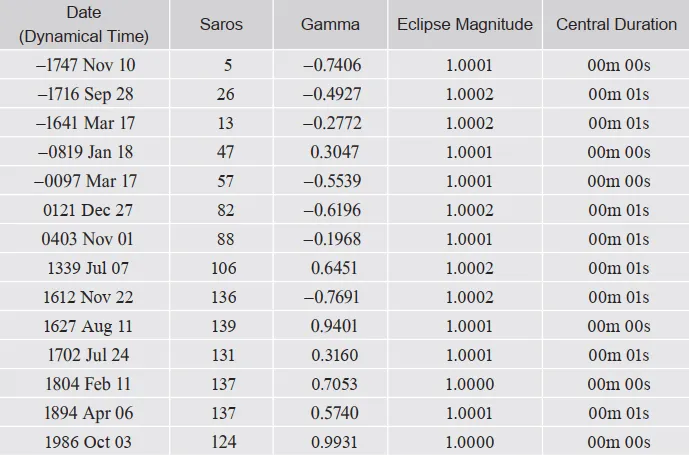
Pic. 11 Hybrid solar eclipses with magnitude 1.00025 or less (Espenak, Meeus, 2006).
The last one such as this was observed in 1986, and indeed they were successful! Thanks to them we have today a good example of a true hybrid solar eclipse and how it exactly looks when the angular dimensions of the Sun and the Moon are exactly the same! The next occasion such as this will happen on April 25, 3372.
5. TYPES OF HYBRID SOLAR ECLIPSES
The Moon revolves around Earth without stopping. It means, that our natural satellite keeps changing its position as well as the distance from its mother planet. The solar eclipse event, which from Earth’s point of view lasts usually several hours is undeniably a result of lunar movement around the Earth. Indeed the lunar movement itself includes also changes in the distance between these two celestial bodies. In a practical sense, the greatest eclipse not necessarily occur roughly at midday. The continuous changes in distance between the Moon and Earth might result in a slight shift between the moment of the greatest solar eclipse against the moment of noon. Threading this way, the Moon’s shadow circumstances between eclipse at sunrise and eclipse at sunset are never the same unless the event takes place around the perigee or apogee. This situation is best visible when a hybrid solar eclipse takes place. Beyond the fact, that the transition points are not at the same distance as the midday point, sometimes the annular-total eclipse might have just one on them instead of two. With respect to it, we can distinguish three types of hybrid solar eclipses.
-> A-T-A (Annular – Total – Annular) – most frequent path with two moments of annular-total, where the central path begins as annular, then becomes total, and finally reverts as annular again. This type reflects symmetric hybrid eclipses in a simplified sense because they never are symmetric ideally (Pic. 12). This type represents 91,2% of all hybrid solar eclipses.
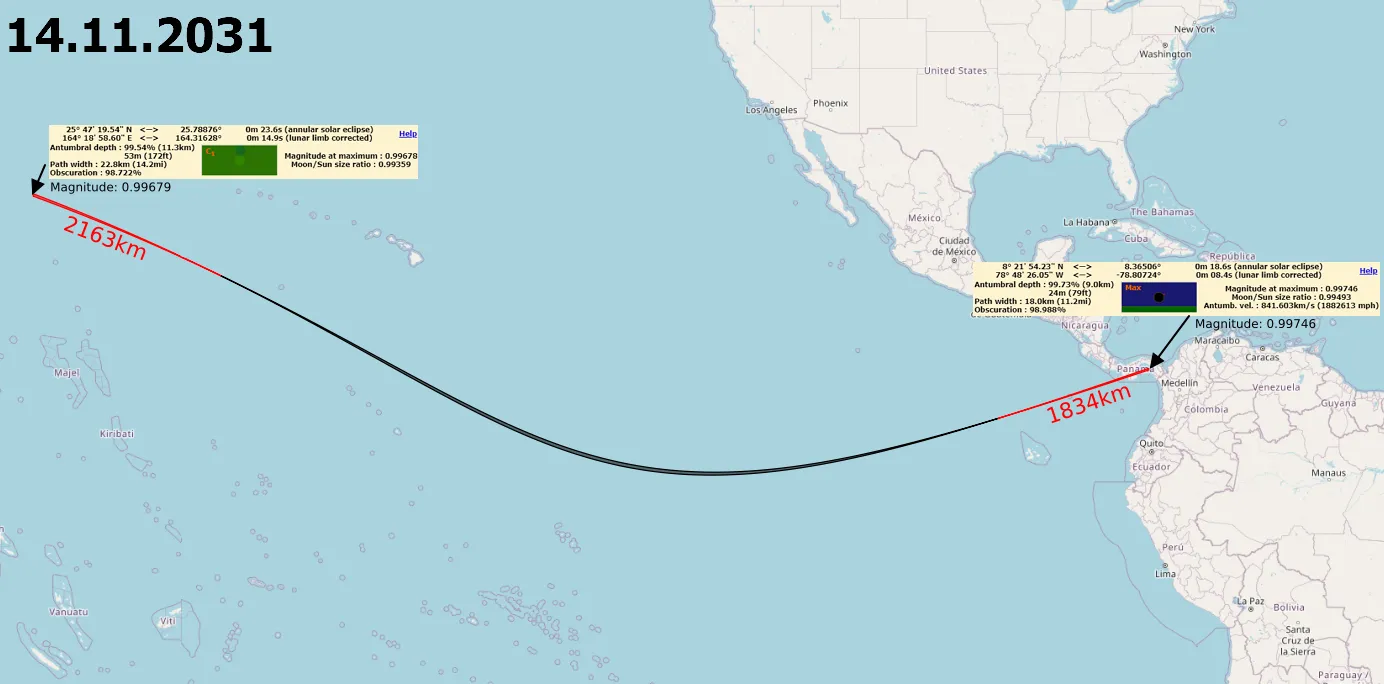
Pic. 12 – 14 The essence of ATA hybrid solar eclipses. Despite calling them “symmetrical” they are the result of changing distance from the Moon to the Earth. The principle is exactly the same as discussed for other types of hybrid solar eclipses presented below, however, this time we can only say about the asymmetry between the length of annularities within the eclipse path.
Let’s take a look at the 2023 hybrid solar eclipse, which occurs on April 20 (Pic. 6). It happens 4 days after the lunar perigee and 8 days before the lunar apogee. It means, that on the eclipse day, the Moon will increase its distance from the Earth. In spite of the A-T-A eclipse type, which would fall under the “symmetrical” type for convenience, the distance alteration to the Earth’s curvature is still observed, which impacts the general character of the eclipse path, as shown in the image above.
Tab. 2 The occurrence of ATA solar eclipse against the lunar apsis between 1901 and 2100.
-> T-A (Total – Annular) – the rarest type of hybrid solar eclipse (4,2%) which starts as a totality, but ends annular near sunset. It occurs in the situation when the distance of the Moon increases by a certain amount. The last eclipse such as this could be observed in 1825 (Pic. 15)
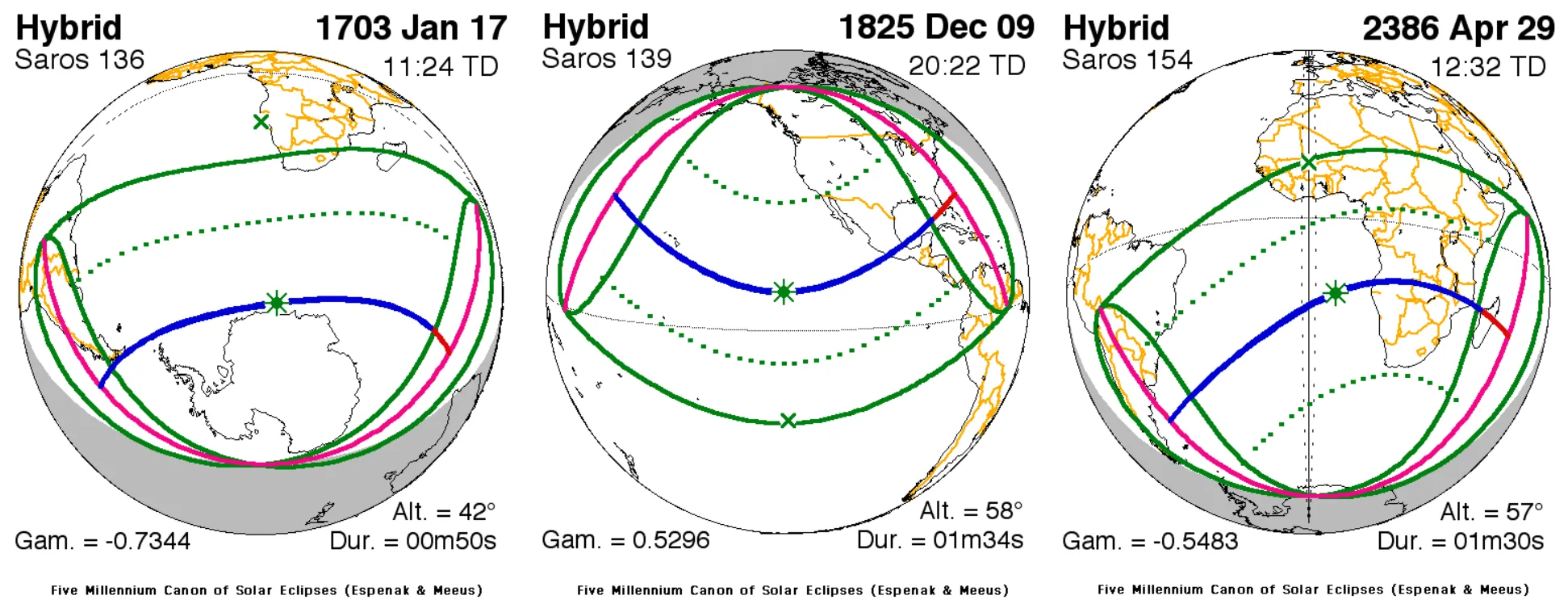
Pic. 15 The 1825 A-T solar eclipse and its rough counterparts before and after (Eclipse.gsfc.nasa.gov).
-> A-T (Annular-Total) – another, the opposite type of the previous one (4,6% of all hybrid eclipses), in which as a result of a decrease in the distance between the Moon and Earth, the eclipse begins as annular at sunrise, but after the transitional moment remains total till the very end (Pic. 16).
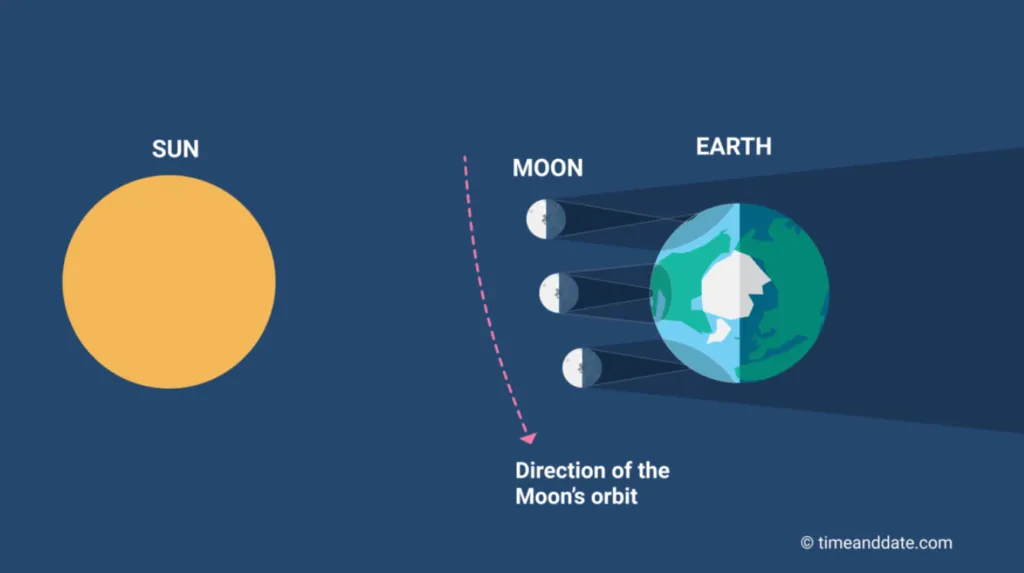
Pic. 16 The Annular-Total (A-T) type of hybrid solar eclipse, where the Moon reduces the distance to Earth across the eclipse path (Timeanddate.com).
The last example of an eclipse such as this occurred on November 5, 2013 (Pic. 5).
The eclipse path, in which the hybrid solar eclipse takes place is always affected by the changes in the distance from the Moon to the Earth, which alters the Earth’s curvature effect. For simplification purposes, it was assumed that asymmetric hybrids always occur when the vertex of the Moon’s
umbral shadow passes through Earth’s fundamental plane during the eclipse (Espenak, Meeus, 2006).
6. HISTORIC OBSERVATIONS OF HYBRID SOLAR ECLIPSES
There are a few spectacular observations of hybrid solar eclipses in modern history. Only the period, in which observers could photograph these events has been considered. It’s effectively just the past century.
The first hybrid solar eclipse in the XX century occurred on June 17, 1909, with mostly total phases across its path despite its short duration, just 0m24s. It was preceded by a very deep annular solar eclipse of 23 December 1908 with a duration at the greatest phase of just 0m12s. Unfortunately due to the unfavorable eclipse locations, there is no information about images and research from the path. The only records lead us to a partial phase visible well from the USA (Rigge, 1909)(Pic. 18).

Pic. 18 The partial phase of the 1909 hybrid solar eclipse visible from Springfield in Montana (Astronomy.williams.edu).
It was the second eclipse with a total phase on Saros 145, which the recent Great American Eclipse of 2017 belongs to.
On the opposite side completely was the next one, which passed through Western Europe. Unlike the previous one, the hybrid solar eclipse of April 17, 1912, was well-studied considering the fact of highly populated areas. This eclipse was rather consociated with the Titanic sinking just 2 days before (called the “Titanic” eclipse by the way). The aim of this eclipse was to measure the lunar limb profile precisely by spreading people every 100m along the straight road to locate precisely the limits of umbral shadow. Another source of lunar limb profile analysis comes from the cinematographic film recorded in Portugal. Because Baily’s Beads weren’t distributed around the Moon symmetrically, the difference between lunar equatorial and polar diameters was noticed by observation of how the lunar valleys grazed the solar disk in the direction perpendicular to the Moon’s movement (Bonifacio, Malaquias, Fernandes, 2010). The difference between the equatorial and polar diameters was estimated as equal to twice the half height of a lunar mountain (4km) plus the space traveled by the Moon during the Baily’s Bead’s 4,4 seconds of invisibility (Bonifacio, Malaquias, Fernandes, 2010).
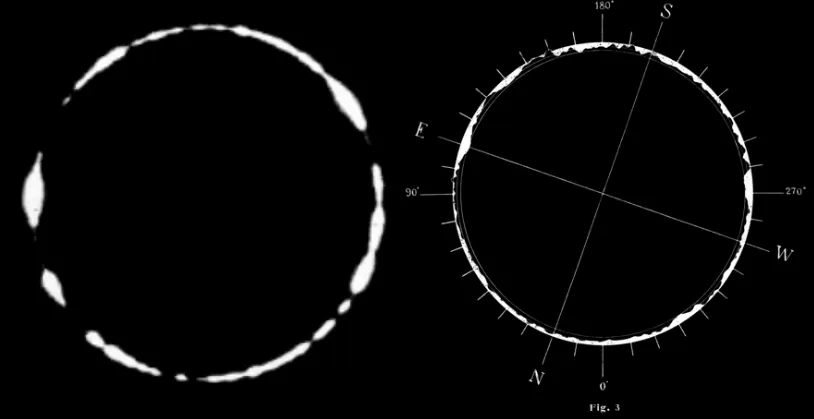
Pic. 19 The pearled annular solar eclipse observed from Paris outskirts on April 17, 1912 (left) and lunar limb profile calculated for this location (Charles Vérax/Xjubier.free.fr).
During this eclipse event, the first observation flight in history took place. The “military-type” aircraft was used for this purpose. In northern France also spherical balloons were used for the eclipse observation.

Pic. 20 Hybrid solar eclipse 1912 as seen from Portugal (left – José Comas Solá) and France (middle and right with corona – André Danjon)(Xjubier.free.fr).
This eclipse was one of the most extreme hybrid solar eclipses. The greatest phase of totality reached just 2 seconds west of Portugal.
The next hybrid solar eclipse on April 28, 1930, in California peaked with just 1 second of totality (Pic. 21).
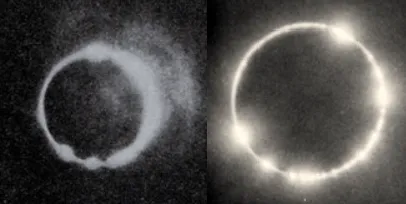
Pic. 21 Hybrid solar eclipse captured over Camptonville in California (Xjubier.free.fr).
It was another occasion for scientific measurements, especially, since this eclipse was on the same saros as the previous one in 1912 and the other one in 1948 described later in this article. This time the subject of study was measurements of the path position of the Moon’s umbra and the accuracy of the lunar limb profile. The very brief period of the eclipse was recorded from an airplane over California. The maximum width of totality in California was about 1000m.
The most spectacular and extreme hybrid solar eclipse was observed on October 3, 1986, from the plane. The biggest specificity of this eclipse was its duration calculated as 0.08s. Being on the plane at an altitude of about 12,2km, finally reducing the distance to the Moon by 108km as per the pattern below (Pic. 22),

Pic. 22 Hybrid solar eclipse 1986 eclipse flight circumstances, as explained in the picture (Nicmosis.as.arizona.edu).
the observer could increase the angular size of the Moon with respect to the Sun by 0,8″, which made a difference for this type of eclipse. Due to the eclipse path shift driven by cruising altitude, they are estimated to be about 110km closer to the Moon than from the Earth’s surface.
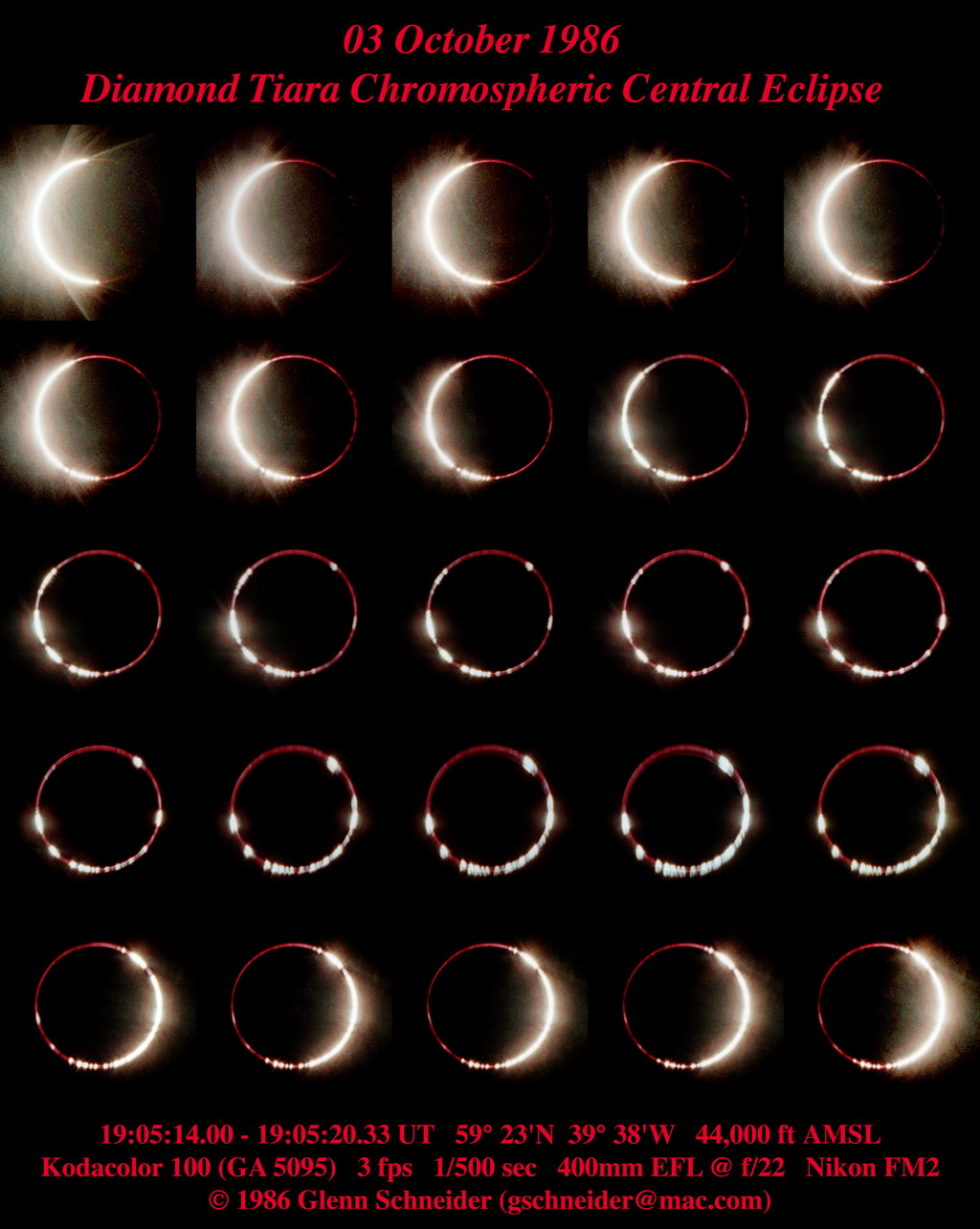
Pic. 23 Hybrid solar eclipse observed above the Atlantic south of Greenland on October 3, 1986 (Glenn Schneider/Nicmosis.as.arizona.edu|Xjubier.free.fr).
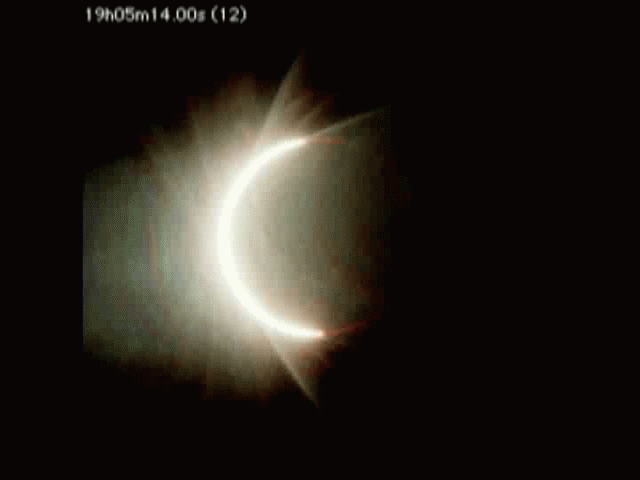
Pic. 24 The best example of a hybrid solar eclipse ever recorded – 3.10.1986 above West Atlantic (Glenn Schneider/Eclipse.star.gs).
This is a perfect example of a true hybrid solar eclipse, where the umbral conical apex meets exactly an observer. This eclipse could be expected to be just annular from the sea level. Changing altitude was really beneficial in this marginal type of eclipse. In fact, the shadow tip was much higher than the flight altitude, on the other hand, the flight was a tad off the track resulting in “an extremely deep partial solar eclipse“. Watching the “true” total solar eclipse with complete photospheric extinction would have required flying much higher than was possible at that time or being located in the space station.
For the purpose of this flight, the eclipse path calculations must take into account the shift of the path. The centerline for an altitude of over 12 km has a different location, than at sea level. Moreover, it was different within other altitudes considered (11,6, 12,2, and 12,8 km above sea level). Because the eclipse was observed at a low altitude, just 6° above the horizon – the refraction correction was also needed. When the eclipse occurs low above the horizon, refraction tends to bend the shadow cone significantly downwards.
This eclipse was unusual for other reasons:
– some observers from the plane could see “how the shadow moved past them”, although “no sharp shadow approached“. The shadow eventually was observed on cloudtops as ” a blob of spilled ink” or “dark stain shaped as a squashed cigar”,
– solar corona appeared to be visible for “a fraction of a minute”,
– more than a “double diamond ring” was observed (diamond tiara),
– probably the most detailed and meticulous calculations were ever made prior to this eclipse. GPS wasn’t popular at that time yet, the Loran-C (hyperbolic radio navigation) was in use instead,
– nobody knows really for how long the totality lasted, it’s rather a matter of individual opinions,
The primary downside of this report was the lack of image sharpness due to plane vibrations and window distortions. Nevertheless, the primary goal has been achieved and marked a significant step in the solar eclipse study across history!
The next hybrid solar eclipse followed directly in 1986, just less than half a year later on March 29th, 1987. It’s an example of a double hybrid solar eclipse combination, in which an observer can see two consecutive hybrid solar eclipses within just one year. It happens quite often, especially in the centuries, in which a multitude of hybrid solar eclipses occur. In the previous century, we had two situations such as this. The first one occurred in the pair of Dec,1908-Jun,1909, and the next one in the pair of Oct,1986-March,1987 as discussed now. There is one occurrence of the hybrid solar eclipse pair in the XXI century – the par or Nov,2049-May,2050. In extreme situations, we can see even 3 double hybrid solar eclipse pairs within a decade! The examples such as these could be observed in the following decades BC 1650-1641, AD 1661-1670, and AD 1681-1690 and will be observed next in AD 3501-3510 and AD 3521-3530. In fact, we could distinguish also the pairs of hybrid solar eclipses, whose occurrence is enclosed within the calendar year. It does happen in series including about 40 pairs in the span of 6-7 centuries, which are separated by another 11-12 centuries from each other. In turn, the “rich” and “poor” periods are marked. The last “rich” period started in AD 1144 and finished in AD 1825 with a group of 41 years (Meeus, 2002). Now, we are in a “poor period” including just 8 A-T couples between 1825 and 2500 (Meeus, 1997), which are not enclosed within one year. Next, the new “rich” group of events such as these will begin in AD 3051 (Meeus, 2002).
The total phase on March 29, 1987, occurred above the central Atlantic before the umbra hit Gabon. The only observation results come from Gabon, where people could enjoy a pearled annular solar eclipse (Pic. 25).
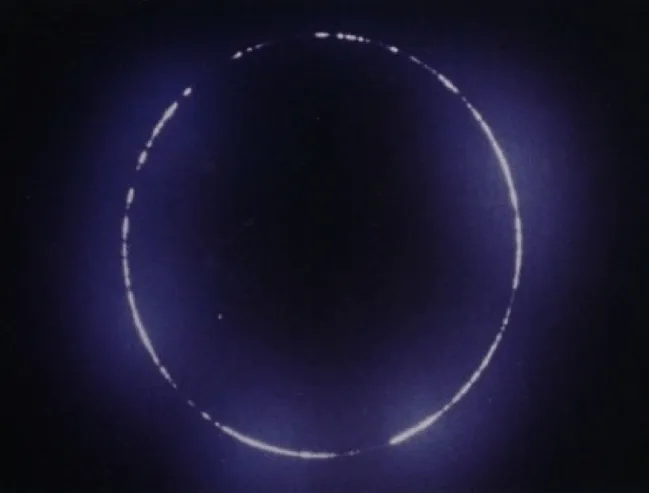
Pic. 25 Pearled annular solar eclipse observed in Gabon on March 29, 1987 (Huguette Guertin/Xjubier.free.fr).
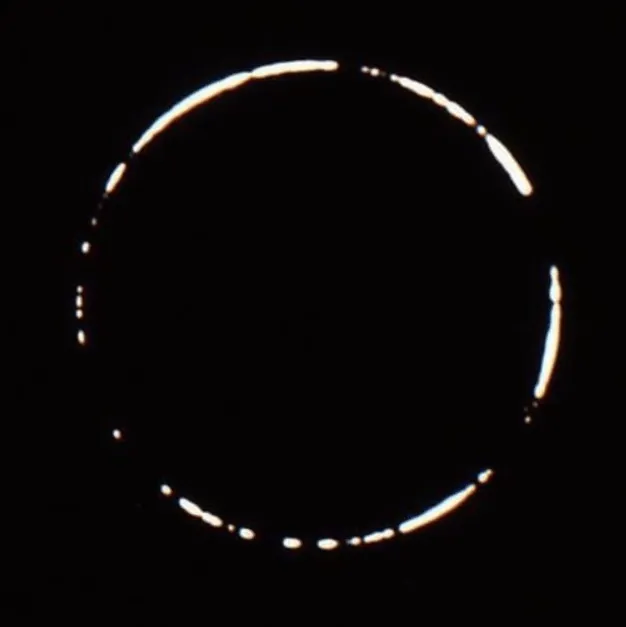
Pic. 26 Pearled annular solar eclipse observed in Gabon on March 29, 1987 (Osamu Ohgoe/Xjubier.free.fr).
Another unfavorable condition that day was the weather. Images were possible at most through thin clouds. It was another eclipse, where reliable measurements of true photosphere radius as well as the variability of solar radius were possible. Indeed, we can find them on Xavier Jubier’s eclipse page, where attempts such as these were obtained by using the Solar Eclipse Maestro software.
The hybrid solar eclipse of April 8, 2005, resulted from a fantastic comparison between the broken-ring annular and shallow total phase, compared well in the image below (Pic. 27).
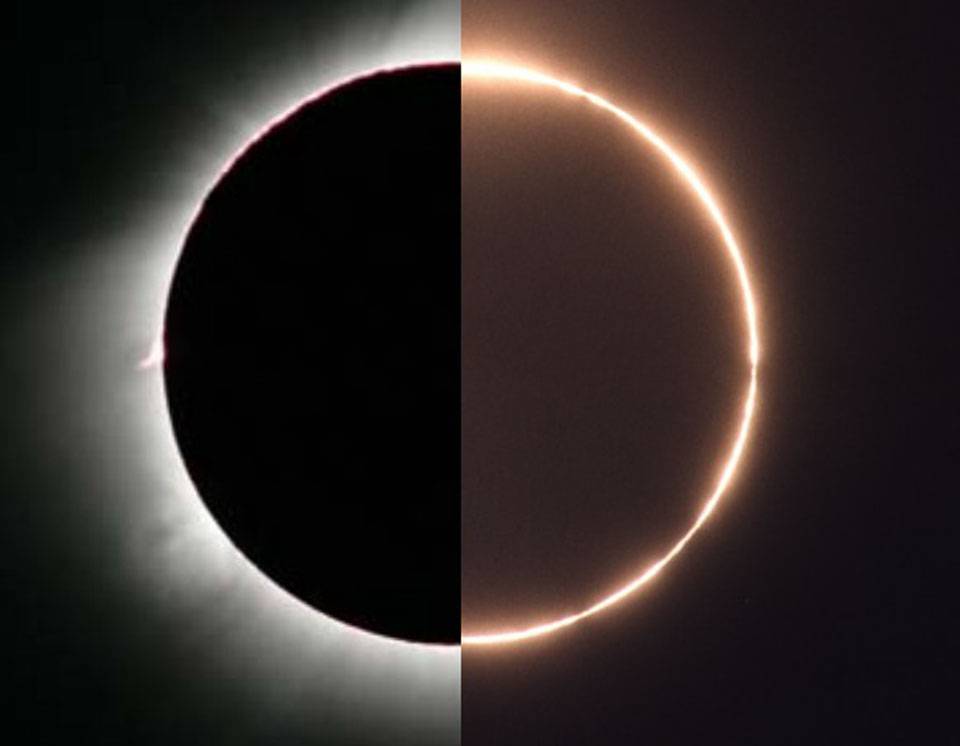
Pic. 27 The comparison between deep annular (broken-ring) and shallow total phase made as a result of observation of the hybrid solar eclipse of April 8, 2005 (Left: Fred Espenak/Right: Stephan Heinsius/Apod.nasa.gov).
The left image has been captured about 2000 km west of the Galapagos Islands, and the right one in Panama (Pic. 28). By correlating them with the eclipse path we can clearly understand the general essence of the hybrid solar eclipse.
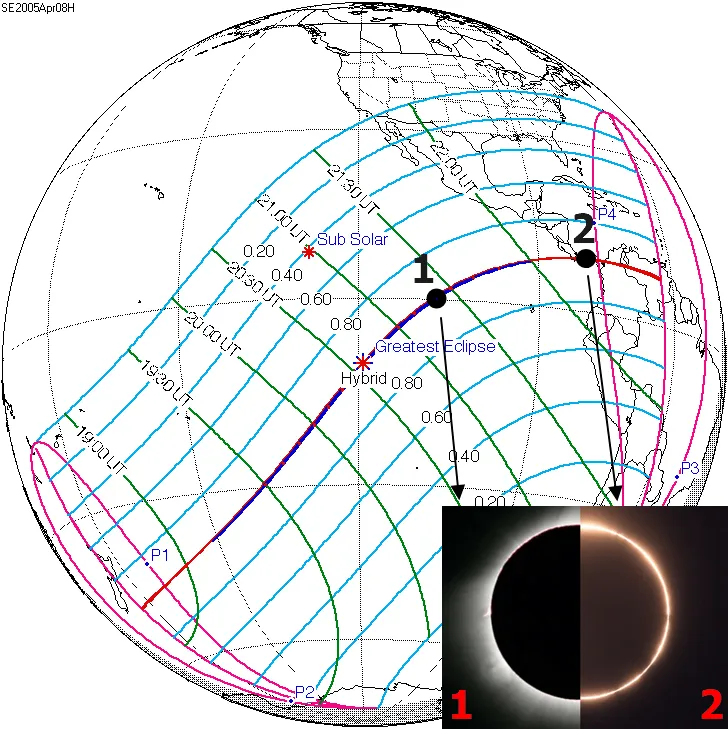
Pic. 28 The estimated locations of April 8, 2005, hybrid solar eclipse images (Eclipse.gsfc.nasa.gov/Apod.nasa.gov).
The last hybrid solar eclipse was observed on November 3, 2013. It was the A-T type of eclipse with a maximum length of the total phase of 1m40s. All reports come rather just from the total phase of this eclipse. Worth attention was for example double-diamond ring effect, typical for short total solar eclipses (Pic. 29). Usually, the diamond ring is observed near the 2nd or 3rd contact, where the single solar rays pass through deep valleys of the Moon’s limb. The moment of 2nd and 3rd contact occurs always at the disappearance (or reappearance) of the solar beams right at the “diamond ring” position angle. The moment of the diamond ring’s disappearance (or reappearance) marks the beginning (or end) of the total phase of the eclipse. In a situation, when the angular size of the Moon barely exceeds the solar one, an observer can see the double-diamond ring effect. It usually occurs on totalities occurring by the way of the hybrid solar eclipse, when the remaining solar arc is extended.
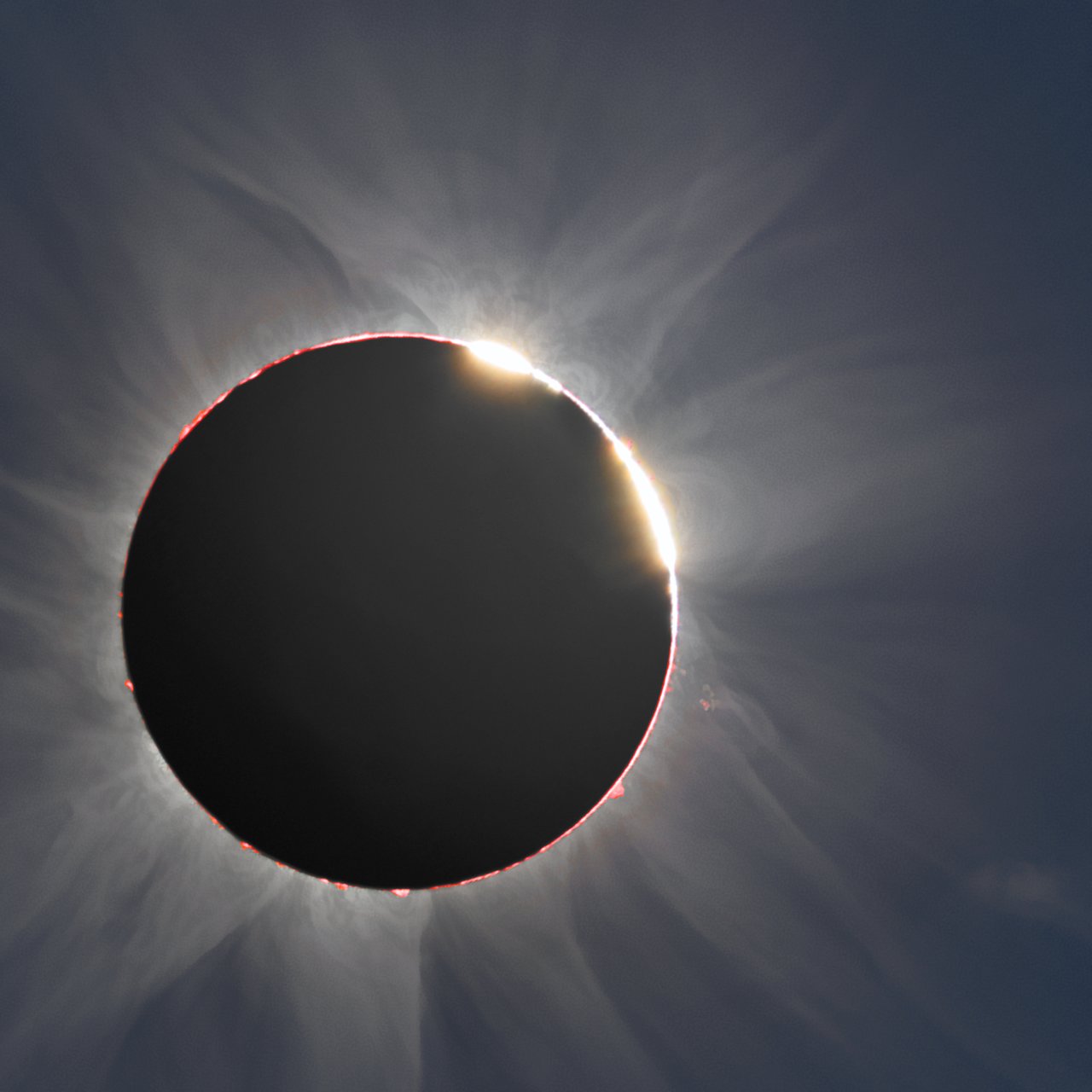
Pic. 29 The double-diamond ring captured near the total phase of the 2013 hybrid solar eclipse (Horalek, Sládeček, Druckmuller/Eso.org).
Another historically successful approach was made by Xavier Jubier’s team, who managed to intercept the fleeting shadow quite close to the transitional point between the annular and solar phases east of the Bermuda Islands (Pic. 30-32).
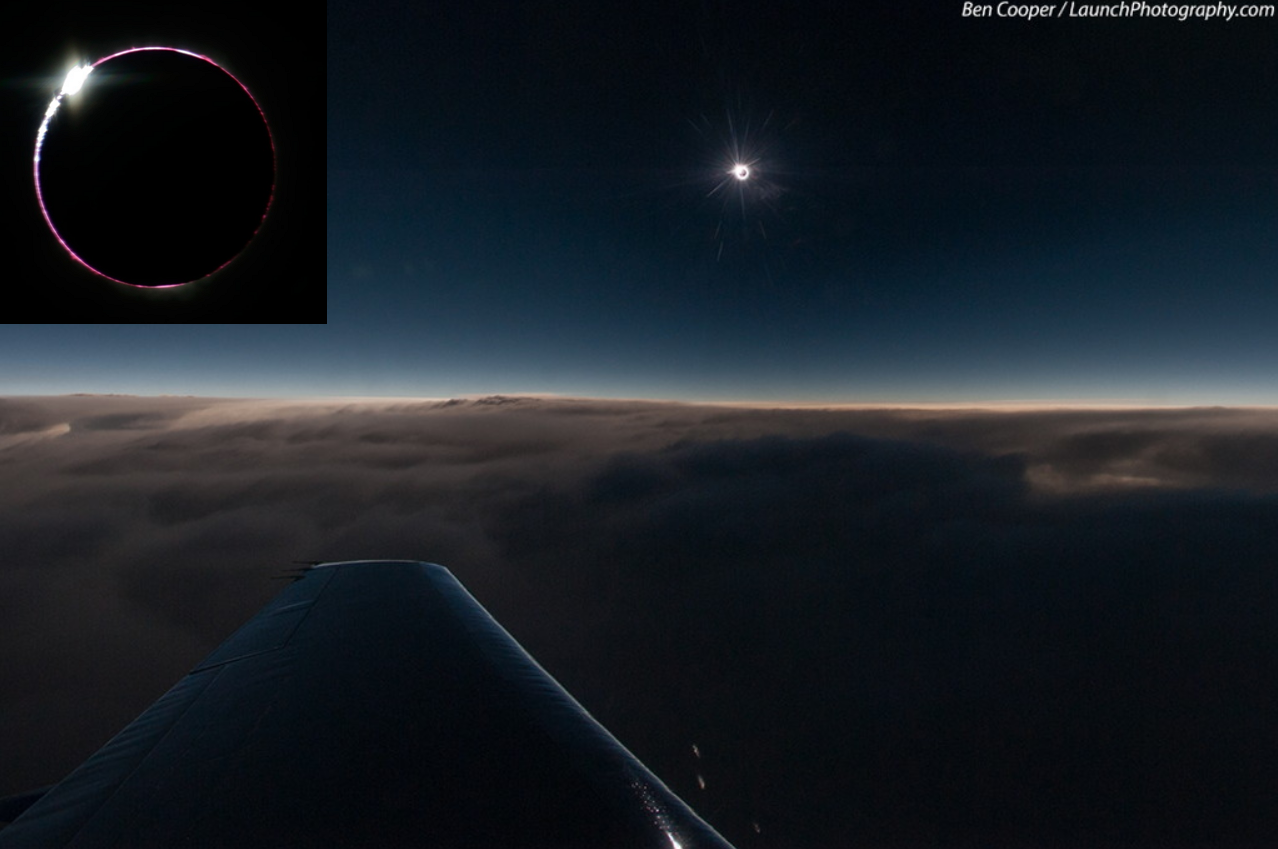
Pic. 30 The lunar shadow captured perfectly during a very short totality (6s) in the 2013 flight east of Bermuda near the greatest phase visible from the plane as presented in the top left corner. After a deep look, we can see, that the aircraft’s wing is already illuminated by single solar beams, whereas the cloud just next to is completely shaded. It doesn’t apply to the other clouds in the foreground, which seem to be slightly illuminated. The clouds in the background are within the sunlight. The visible length of the umbra isn’t bigger than 5 maybe 6 km. In turn, we can say, that the plane was flying right next to a very short totality (Ben Cooper/Launchphotography.com).

Pic. 31 The pearled total solar eclipse phase near Bermuda with all major sequences captured from the plane. It looks like the brief total phase was missed slightly, although capturing an ideal moment of a hybrid solar eclipse seems to be extremely difficult in circumstances such as these (Ben Cooper/Launchphotography.com).

Pic. 32 Flash spectrum visible during 2013 pearled total solar eclipse (Robert Minor/Xjubier.free.fr).
7. HISTORICAL OBSERVATIONS OF DEEP ANNULAR SOLAR ECLIPSES (ON SAROS 137)
As the reference of deep annular phases, which occur within the paths of annular-total solar eclipses it’s good to check the historical observations and images of similar phenomena. These events are related to very deep annular solar eclipses, especially within their greatest phase. The deepest annular eclipse occurred on May 9 at the Sea of Japan. It was admittedly a very similar eclipse to the October 3, 1986 hybrid one, where during the greatest phase the length of annularity lasted just 0.3s with the path width just about 200m at a maximum point. It means, that an observer at an altitude of a few km would have been in a transition point between annularity and totality. The eclipse path on the island of Rebun in northern Japan had a duration of 1.8s-1.9s and a width of about 1400m. This time the primary subject of measurements was similar to the ones carried out during the 1912 and 1930 hybrid solar eclipses discussed earlier. The lunar limb profile circumstances were studied by measuring the variation of the integrated light for the individual beads at their appearance and disappearance (Panay, 1950). Moreover, this solar eclipse was a unique opportunity to determine more accurately relative locations on the Earth’s surface. Observations could assist in connecting some of the geodetic surveys already conducted on the two major land masses of Asia and North America. For this reason, a special geodetic program was launched and was aimed at determining the figure and dimensions of the Earth. The large plumb-line deviation of the Japanese Islands was confirmed (Hagihara, 1955).
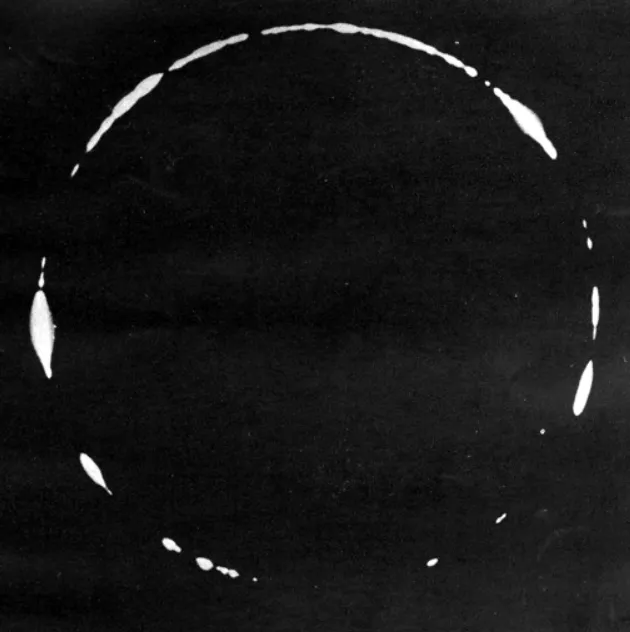
Pic. 33 Extremely deep annular solar eclipse (pearled annular solar eclipse) as seen from Rebun Island (Hokkaido, Japan) (Kyoto University/Xjubier.free.fr).
The next annular solar eclipse worth attention to occurred exactly on the same Saros 137 on May 20, 1966. It was a very similar eclipse also to the past hybrid ones in 1930 and 1912. The greatest eclipse occurred above Greece and Turkey, where observers could enjoy the pearled annular solar eclipse with a duration of just 5 sec on a width of just 3 km. Similarly to the previous one in 1948 (described above), it was a good occasion for accurate measurements of the path position of the Moon’s antumbra. Again, the subject of study was the shape of the lunar limb profile, especially the relief altitudes of the libration zones. (Gorynia, 1970). Moreover, this eclipse was a good occasion for determining corrections for the coordinates of the Moon, in which one of the applied methods was based on the difference between the observed and computed moments of the disc contacts (Gorynia, 1970).
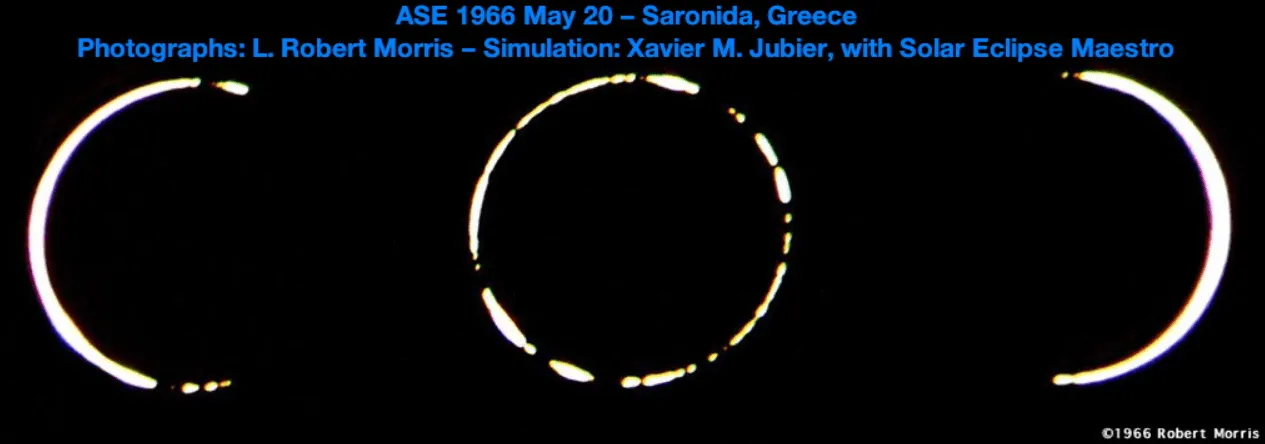
Pic. 34 Pearled annular solar eclipse of May 20, 1966, photographed in Greece (Robert Morris/Xjubier.free.fr).
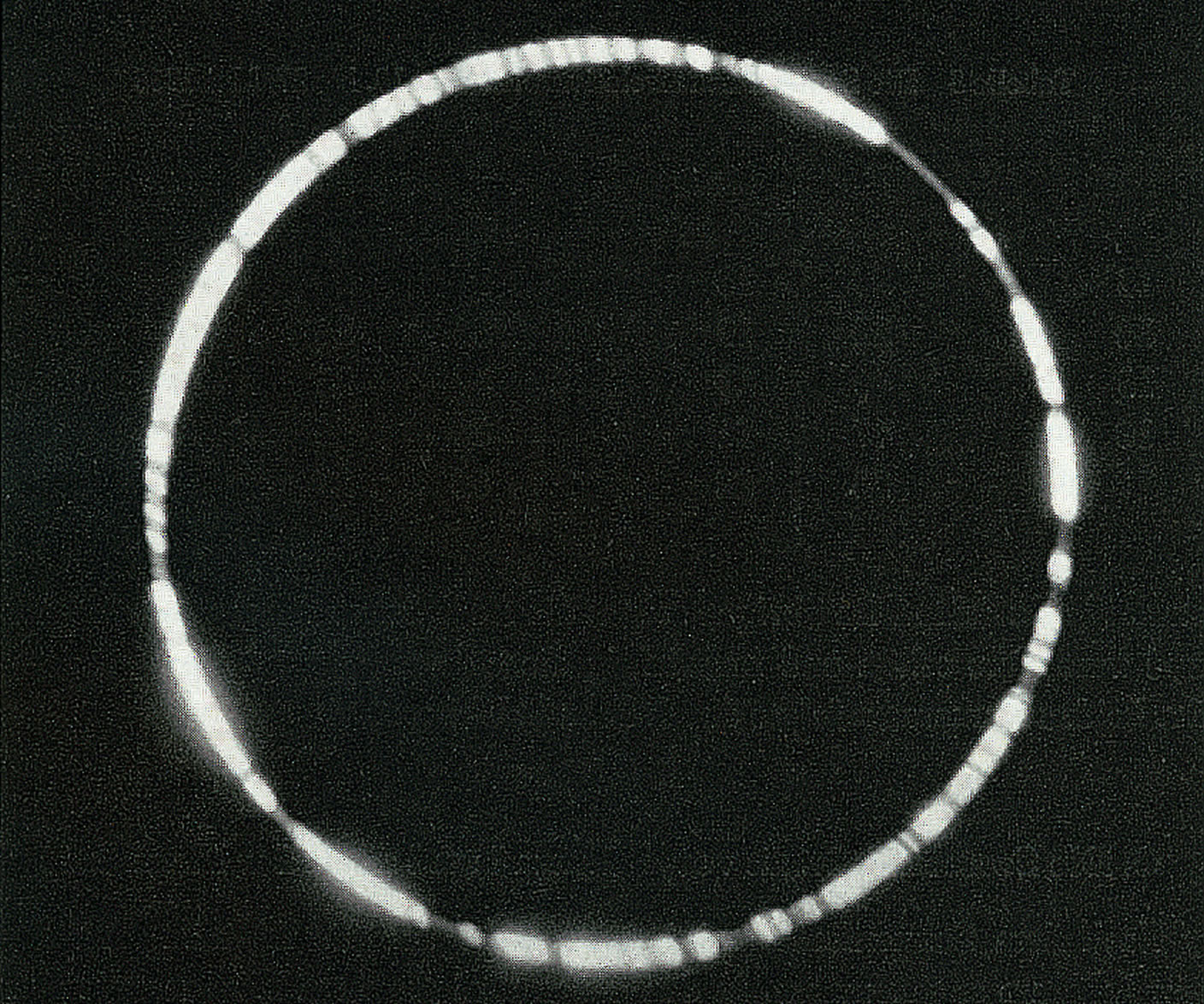
Pic. 35 Pearled annular solar eclipse (Diamond necklace) of May 20, 1966, photographed in Ayvalik in Turkey (Max Waldmeier/Library.etz.ch).
As per observations the brightness of the “Diamond necklace” at the greatest phase was about 1000x larger than the brightness of the innermost solar corona visible for a very short moment.
The last remarkable event worth attention to was the (broken-ring) annular solar eclipse of May 30, 1984, where the apparent diameter of the solar disk was calculated to exceed the lunar one just by 4 arc seconds (Espenak, 1984). In turn, the annularity duration was just 11s with a path width of just 7 km at the greatest phase. This eclipse was observed as the spectacular “necklace of light” and likewise the previous events at the same saros since 1912 it was a great opportunity for accurate measurements of the path position of the Moon’s antumbra and to control lunar limb profile. The “broken” annular solar eclipse was slightly different than the previous ones, the “pearled” ones. We can clearly see, that instead of Baily’s Beads prevailing around the lunar limb, the solar ring can be observed with some discontinuities in places (Pic. 36). Unfortunately, the greatest phase with a duration of just 11,4s wasn’t achievable due to cloudiness. In fact, the images below were made within similar eclipse duration but not exactly in the centerline.
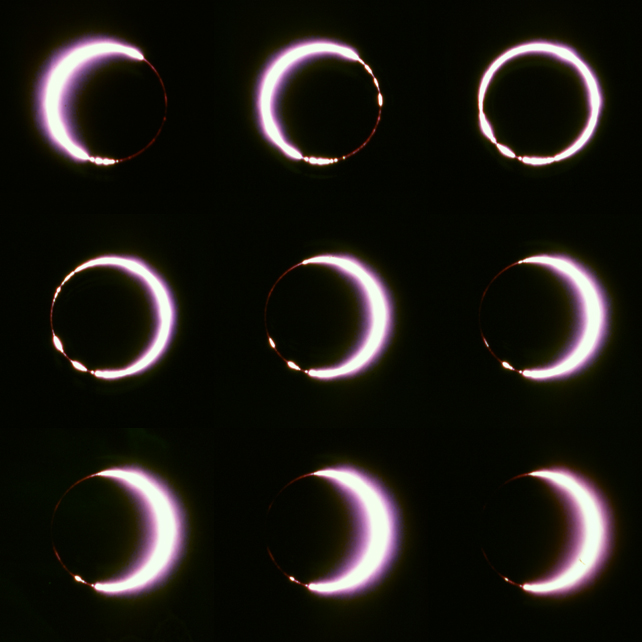
Pic. 36 The broken-ring eclipse observed near Greenville, SC, USA (Glenn Schneider/Nicmosis.as.arizona.edu).
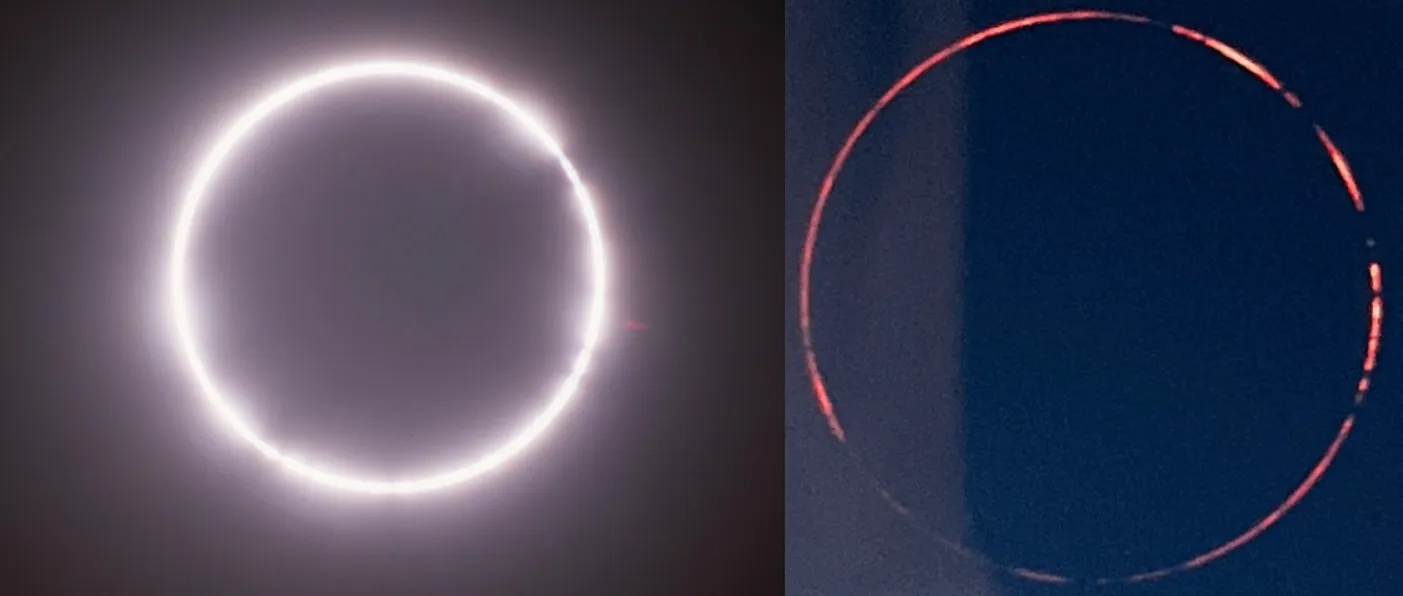
Pic. 37 The greatest phase of the “broken” annular solar eclipse was observed in the USA on May 30, 1984. On the left, we can see the unfiltered image of a broken ring produced by Larry Stevens near Greenville, SC, USA (Pbase.com). On the right, the greatest phase was captured by Paul D. Maley in Atlanta, GA (Pauldmaley.com).
8. HYBRID SOLAR ECLIPSES UNTIL AD 3000
The map presented below fairly depicts the present time with respect to the frequency of hybrid solar eclipses (Pic. 38).
Looking forward, I’ve prepared the map of all hybrid solar eclipses in the current millennium with a focus on the “hybrid points” certainly, having in mind, especially the locations where they will occur (Pic. 16). Despite eclipse flights, which will be probably more available for the observers, the ground-based option should be always easier for chasing an ideal coincidence of lunar and solar disks, which is extremely difficult from the plane.

Pic. 16 The map of hybrid solar eclipses in the third millennium. The blue stars mark hybrid points observed on the sea, their green counterparts – on the ground. Click to enlarge. Get the original size.
In fact, there are not many situations like this. The closest hybrid solar eclipse with a hybrid point occurring on the ground will happen in 2067 (northeast Brazil). The last situation such as this was possible in 1894 (northern China), and another one only in 2182 (northern Algeria, southern Russia). On top of that, however, is not enough data to make the final conclusion, but we can see just barely 28% of hybrid points occurring on land (while one is on a freshwater lake) and about 50% of all the points can be observed inside the tropical zone. What is the reason for the hybrid point distribution such as this? It will require further studies and explanations in the future when other millennia will be taken into account. Concluding, in the following millennium 56 annular-total eclipses take place bringing the total value of hybrid points to 109 exactly. This is because 5 “asymmetric” annular-total solar eclipses are observed (3.11.2013, 17.10.2172 29.04.2386, 24.09.2853, and 28.07.2987). Within just one (29.04.2386) with class 2 (T-A) is to occur.
9. SUMMARY
Usually, the hybrid solar eclipse tends to be perceived as the combination of all the solar eclipse types within just one eclipse event. It does apply to the typical situation when the particular eclipse starts and finishes as an annular being total for a period around noon. This definition of the hybrid solar eclipse is omnipresent even in scientific literature produced by the authors mentioned in this work. It’s not suitable with my point of view, in which I define a hybrid solar eclipse just as the transition moment between the annular and total phases and vice versa. The primary reason for this is the geometry of the lunar shadow. The hybrid solar eclipse should be consociated only with the vertex point – the tip of the cone-shaped umbra. This vertex point means, that both the Moon’s and the Sun’s distance to the Earth is just right, resulting in a magnitude value equal to 1. This geometrical place is the transitional point between an annular and a total solar eclipse. From the visual point of view, an observer’s eye can see the Baily’s Beads spread around the whole lunar limb. Some sources call this eclipse the “beaded” one, which can be also correct at some point. A view such as this is restricted to the extremely narrow path, which means also the central eclipse. The specificity of these eclipse events clarifies easily, that they’re never symmetric likewise other eclipse events, in which this geometrical feature is not easily noticeable.
The proper definition for all types of solar eclipses occurring in one event should be the annular-total solar eclipse instead of the hybrid one. It will still stress to anyone, that the eclipse event is peculiar and includes at least one place on its path, where the hybrid solar eclipse can be observed. In fact, calling these events annular-total solar eclipses can cause confusion when the total-annular (T-A) type of eclipse is to be observed. This is probably why the hybrid solar eclipse has been used in scientific nomenclature instead. As we can see, the nomenclature of these eclipse events can be problematic. Important is to make people aware, of what exactly type of eclipse can they observe from their location during the annular-total solar eclipse event.
Hybrid solar eclipses themselves are extremely rare and observed pretty much once a decade on average. Its various distribution in time means, that they can be watched even 6 times in a given decade or being not visible for 113 years conversely.
Because of their specificity and rarity, these types of eclipse events remain a huge challenge for observers. The best examples are eclipse flights, which prove how extremely difficult is to meet the fleeting vertex point when an observer is in motion. The only hope for an ideal image of the hybrid solar eclipse is chasing it from the ground, although the chances are really small across the millennium. Most generations never have had an occasion to experience an event like this anywhere worldwide! The hybrid solar eclipses give the best opportunity for studying i.e. the lunar limb profile as well as making corrections for further eclipse computations.
Appropriate calculation of the path, especially the centerline is extremely important for the eclipses such as described in this text. This is because the hybrid solar eclipse occurs in extremely small areas and can be easily missed. Indeed, the best image of a hybrid solar eclipse comes from 1986, but the primary goal, which is capturing the perfect fit view of the hybrid solar eclipse hasn’t been achieved so far. The same applies to extremely deep annular solar eclipses or extremely shallow total solar eclipses observed roughly at the centerline near the transitional point. The fundamental parameter used for predictions of solar eclipses is the Moon’s mean radius ‘k’ expressed in the Earth’s equatorial radius. As per our earlier discussion, we need to be aware, that using two different values of k for central eclipses will result in a discontinuity in the case of hybrid or annular-total eclipses. The problem will come out also when dealing with extremely deep annular solar eclipses. One of the best examples is the 1966 annular solar eclipse, for which the difference in the centerline computed by USNO and Meeus reaches 1km!. The same dealings apply to extremely shallow total solar eclipses and, of course also to the grazing zones, whichever solar eclipse applies to.
Mariusz Krukar
References:
- Bonifacio V., Malaquias I., Fernandes J., 2010, The first astronomical hypothesis based on cinematographical observations: Costa Lobo’s 1912 evidence for polar flattening of the moon, (in:) Journal of Astronomical History and Heritage 13(02)
- Espenak F., 1984, Predictions for the annular solar eclipse of 1984, (in:) Journal of the Royal Astronomical Society of Canada, vol. 78, p.10-31
- Espenak F., Meeus J., 2006, Five Millenium Catalog of Solar Eclipses: -1999 to +3000 (2000BCE to 3000 CE) – Revised, Goddard Space Flight Center, Greenbelt, Maryland
- Explanatory Supplement to the Astronomical Ephemeris and the American Ephemeris and Nautical Almanac, 1974, Her Majesty’s Nautical Almanac Office, London
- Gorynia A.A., 1970, Annular Solar Eclipse, May 20, 1966, Issue 621, National Aeronautics and Space Administration, Springfield, Va. University of Illinois at Urbana-Champaign
- Hagihara Y., 1955, Recent eclipse work in Japan, (in:) Vistas in Astronomy, vol.1, 1955, p.708-713.
- Litmann M., Espenak F., Willcox K., 2008, Totality Eclipses of the Sun, Third Edition Oxford University Press, Oxford, UK.
- Meeus J., 1997, Mathematical Astronomy Morsels, Willmann-Bell Inc. Richmond, Virginia
- Meeus J., 2002, More Mathematical Astronomy Morsels, Willmann-Bell Inc., Richmond, Virginia
- Meeus J., Grosjean C.C., Vanderleen W., 1966, Canon of solar eclipses, Pergamon Press, Oxford, United Kingdom
- Mobberley M., 2007, Total solar eclipses and how to observe them, Springer
- Moreoux T., 1912, Comment verrons-nous l’éclipse du 17
Avril 1912?, (in:) Revue Générale des Sciences Pures et
Appliquées, 23, 170-171. - Panay T.N., 1950, Note on measurements of the films of the solar eclipse, May 9–8,1948, (in:) Eos, Transactions American Geophysical Union, vol. 31, issue 6, p. 809-815
- Pasachoff M.J., et al., 2006, The April 8, 2005, Eclipse White-Light Corona, (in:) Solar Physics 238, p.261-270.
- Rigge W. F., 1909, The Solar Eclipse of June 17, 1909 as Visible in the United States, (in:) Popular Astronomy, vol. 17, p.282-284
Links:
- https://www.timeanddate.com/eclipse/hybrid-solar-eclipse.html
- https://www.space.com/hybrid-solar-eclipse-guide
- https://www.eclipseland.com/
- Geogebra.org: Solar eclipse 3D
- https://sites.williams.edu/eclipse/ring-of-photosphere-eclipse-21st-june-2020/
- Eclipse.gsfc.nasa.gov: Five millenium catalog of hybrid solar eclipses
- Eclipse.gsfc.nasa.gov: Five Millenium Catalog of Asymmetric Hybrid Solar Eclipses
- Eclipse.gsfc.nasa.gov: Catalog of all longest annular & total & hybrid solar eclipses between 3999BC and 6000AD
- Eclipse.gsfc.nasa.gov: Catalog of longest hybrid solar eclipses (over 1m30s) between 3999BC and 6000AD
- https://rulawe.com/hybrid-solar-eclipse-what-is-it-and-how-does-it-arise/
- https://eklipso.wordpress.com/2018/03/27/what-is-a-hybrid-solar-eclipse/
- https://stargazersclubwa.com.au/hybrid-solar-eclipse/
- https://solarsystem.nasa.gov/eclipses/about-eclipses/types/
- https://www.csmonitor.com/Science/2013/1103/Solar-eclipse-What-s-a-hybrid-eclipse-and-how-does-it-work
- https://www.abc.net.au/news/2019-05-24/rare-hybrid-eclipse-in-2023-sells-out-exmouth-accommodation/11143178
- https://abcnews.go.com/Technology/rare-hybrid-solar-eclipse-spotted-atlantic-ocean/story?id=20776075
- https://astronomy.williams.edu/hopkins-observatory/eclipse-viewers/
- Eclipsewise.com: Solar Eclipse Predictions and the Mean Lunar Radius
- Mreclipse.com: Total solar eclipse 2005 photo gallery.
- Eumetsat.int: Rare hybrid solar eclipse 2013
- Space.com: Rare hybrid solar eclipse explained (2013)
- Eso.org: The double-diamond-ring effect seen during the hybrid solar eclipse of 3 November 2013
- https://portugal.postsen.com/tech/187135/What-is-a-hybrid-solar-eclipse-rare-event-expected-in-2023.html
- https://www.electriccitymagazine.ca/hybrid-solar-eclipse-what-is-it-and-how-does-it-happen/
- https://www.coronetdiamonds.com/the-diamond-ring-effect-of-a-solar-eclipse/
- Library.ethz.ch: Phenomena during solar eclipses
- https://www.cbc.ca/news/multimedia/how-people-watched-solar-eclipses-in-the-last-century-1.4243992
- Eclipse.star.gs: Hybrid solar eclipses 1986-2067
- Bnn-news.com: Hybrid solar eclipse observed countries 2013
- https://www.eclipseland.com/en/germany-1912-hybrid.html
- Astronomeer.com: Hybrid solar eclipse 1912 Netherlands
- Theskylive.com: Solar eclipse of May 9, 1948
- Sonnenfinsternis.org: Annular solar eclipse of May 9, 1948
- Hybrid solar eclipse of 3.10.1986
- Almanak.hi.is: Hybrid solar eclipse 1986 – a live record
- Almanak.hi.is/: 1986 Hybrid solar eclipse relation by Glenn Schneider
- Almanak.hi.is: Hybrid solar eclipse 1986 relation by Ragnar Axellson (Published in 2010)
- Almanak.hi.is: The solar eclipse of October 3, 1986 – full relation by Thorsteinn Saemundsson
- Eclipsophile.com: 1986 Hybrid solar eclipse
- Eclipse.gsfc.nasa.gov: Hybrid solar eclipse 1986 circumstances
- Nytimes.com: Broken-ring annular eclipse of 30.05.1984
- Broken annular eclipse of 30.05.1984
- https://www.nytimes.com/1984/05/31/us/millions-in-south-treated-to-rare-view-of-solar-eclipse.html
- https://www.pbase.com/photographerlarry/annular_solar_eclipse_1984
- https://pauldmaley.com/2022/07/19/1984-annular-solar-eclipse-usa-results/
- Nicmosis.as.arizona.edu: Annular solar eclipse 1984 by Glenn Schneider
- Apod.nasa.gov: A rare hybrid solar eclipse – 8.04.2005.
- https://www.eclipseland.com/en/panama-2005-hybrid.html
- Lunar perigee or apogee calculator
- Xjubier.free.fr: Five Millennium catalog of solar eclipses 2000BC – 3000AD
- Eclipsewise.com: Six Millennium catalog of solar eclipses 3000BC to 3000AD
- 8 Millemium of solar & lunar eclipses catalog: 4000BC – 4000AD
- Xjubier.free.fr: 1912 Hybrid solar eclipse
- Xjubier.free.fr: 1930 Hybrid solar eclipse
- Xjubier.free.fr: 1948 Annular solar eclipse
- Xjubier.free.fr: 1966 Annular solar eclipse
- Xjubier.free.fr: 1984 Annular solar eclipse
- Xjubier.free.fr: 1986 Hybrid solar eclipse
- Xjubier.free.fr: 1987 Hybrid solar eclipse
- Xjubier.free.fr: 2005 Hybrid solar eclipse
- Xjubier.free.fr: 2013 HSE eclipse flight
- Xjubier.free.fr: 2023 HSE eclipse flight
- https://www.launchphotography.com/
- Xjubier.free.fr: Solar Corona Shapes between 1900 and 1937
Forums:
- https://www.quora.com/What-is-the-difference-between-annular-eclipse-and-hybrid-eclipse
- https://www.quora.com/What-was-the-shortest-totality-of-a-solar-eclipse
Wiki:
- List of solar eclipses in the 20th century
- Loran-C
- Solar eclipse of June 17, 1909
- Solar eclipse of April 17, 1912
- Solar eclipse of April 8, 2005
- Solar eclipse of November 3, 2013
- Solar Saros 137
- Solar Saros 145
Movies:

